Fifth Period
Join students Sophie, Tomás, Emma, and Marcus during Fifth Period! This STEM comic strip chronicles the exciting and often hilarious adventures of a close-knit group of four friends as they learn about science, technology, engineering, and math from their kooky, inspiring, off-the-wall science teacher, Mr. Kepler. When they're not in class, these kids love to explore the vast world of STEM on their own, launching weather balloons, programming computer games, and cataloging insects, sometimes with unpredictable and highly entertaining results!
September 28, 2012
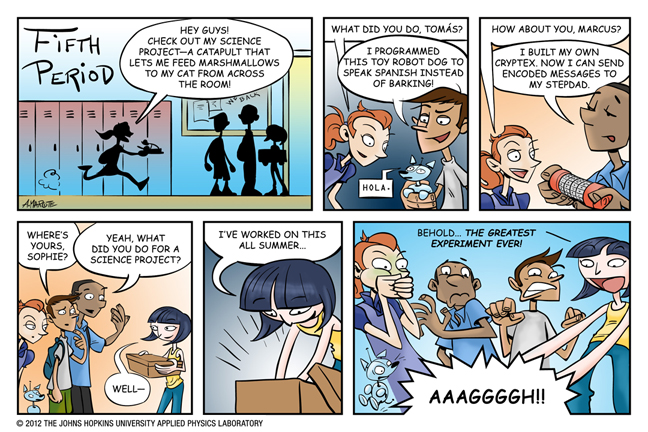
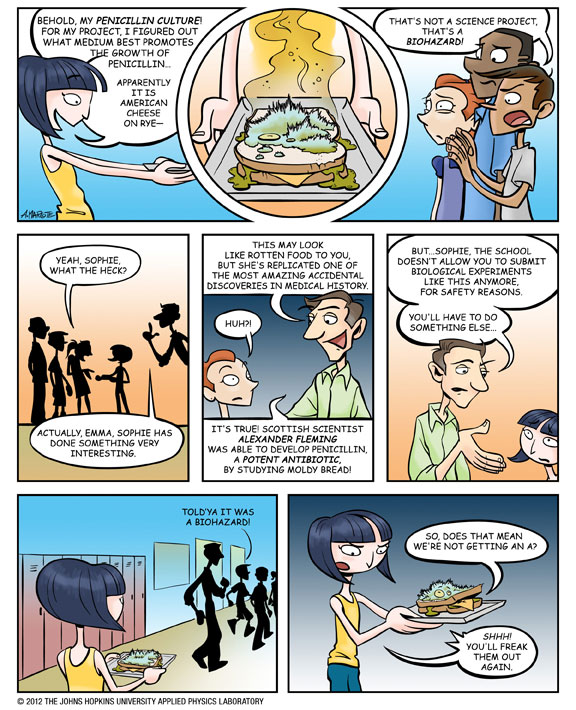
November 2, 2012
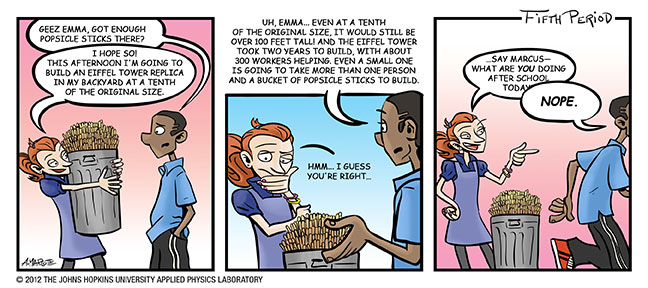
Estimating and Proportion

How did Marcus figure out so quickly that Emma had bitten off more than she could chew? Well, he already knew that the Eiffel Tower was 1,063 feet tall, so when Emma said she wanted to make a copy that was a tenth of the size, all he had to do was divide by ten, giving him 106.3 feet tall—still pretty big! The trick he used was simple: whenever you are dividing by a multiple of ten (like 100, 1,000, or 1,000,000), take the dividend (the number that is being divided) and place a decimal point as many places to the left as there are zeroes in the divisor (the number you’re dividing by). For example: 4,789 (the dividend) ÷ 100 (the divisor) = 47.89… two zeroes means two decimal places to the left!
Try it yourself!
If Emma decided she wanted to make a tower that was only one-thousandth of the size of the real thing, do you think she could build it all by herself? How many popsicle sticks do you think she has in her bucket? Do you think she’d need to use all of them to build the miniature tower, or would she still have some left over?
November 16, 2012
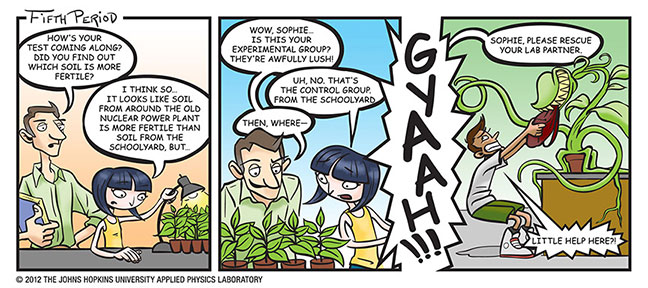
Sophie's Scientific Method

What did Sophie find out from her experiment with the plants? (You know, besides the fact that she owes Tomás a new backpack!) She discovered that soil from around the old nuclear power plant is more fertile than regular old soil from the schoolyard. She was able to do this by comparing the two, using a process called the scientific method. The scientific method has been used for centuries to make some of the world's greatest discoveries!
Here are the steps to Sophie's Scientific Method:
- She asks some questions: 'Is some soil more fertile than other types of soil? Which is more fertile, soil from the schoolyard or soil near the old nuclear power plant?'
- She makes a hypothesis: 'Soil near the old nuclear power plant is more fertile than schoolyard soil.'
- She makes a prediction: 'If the power plant soil is more fertile, then seeds planted in it will develop into larger, healthier plants.'
- She tests her hypothesis: 'I'll plant seeds in soil samples from both the schoolyard and the old nuclear power plant, and I'll see which samples grow larger plants!'
- She analyzes her results: 'Soil near the power plant is not only more fertile than schoolyard soil; it is also more likely to turn your seeds into classmate-eating monsters.'
Try it yourself!
Sophie wants to figure out how to tame her new 'pet.' What steps should she take to figure out what it responds to?
December 7, 2012
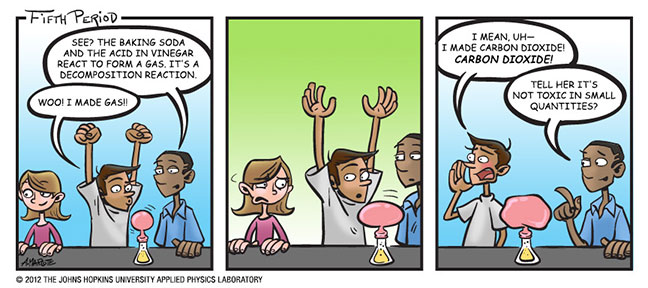
Tomás Has Gas…

…No…not that kind. Tomás and Marcus made carbon dioxide by adding baking soda to acetic acid (the stuff in vinegar), and what happened is known as a decomposition reaction. That's when a chemical's molecules break up into even smaller molecules. More molecules take up more volume, and with nowhere to escape, it can really build up some pressure! Just look how that balloon is expanding....
You can harness this expanding gas to do some pretty cool stuff, like make a powerful rocket! It won't get you into space, but it can shoot pretty far into the air, so be sure to GET OUT OF THE WAY.
Try it yourself!
Could you figure out how to make a baking soda/vinegar-powered car, using simple materials like a milk carton, spools, wooden dowels, and a plastic bottle? Gather your friends, and have a race!
December 21, 2012
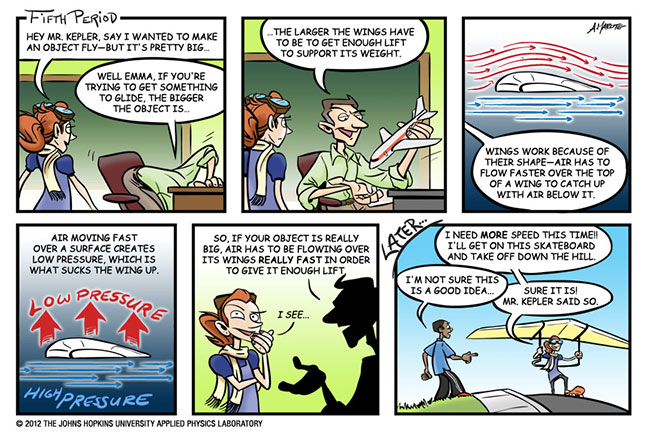
Bernoulli's Principle at Work

What Mr. Kepler was explaining to Emma was the effect of Bernoulli's principle on aircraft, which states that with the flow of a fluid (like air), when the speed of a fluid increases, the pressure of the fluid decreases. Emma figured out that she wasn't getting enough low pressure above the wings of her aircraft to give her enough lift. She decided the solution was a faster air flow—more SPEED. We'll find out later if she was able to get enough lift!
Try it yourself—with paper airplanes, not the skateboard and glider!
You can see the effect of size and speed on an aircraft by using simple paper airplanes! Experiment like this: Take a small paper airplane and a larger one that's been folded with thicker, sturdier paper. First test with light tosses, and then test with more powerful tosses. See which airplane goes farther in each case.
This experiment works even better if you have two differently sized toy gliders—look for them in a dollar store! When you toss them, which do you observe going farther, the large one or the small one? Can you explain what happens using Bernoulli's principle?
January 4, 2013
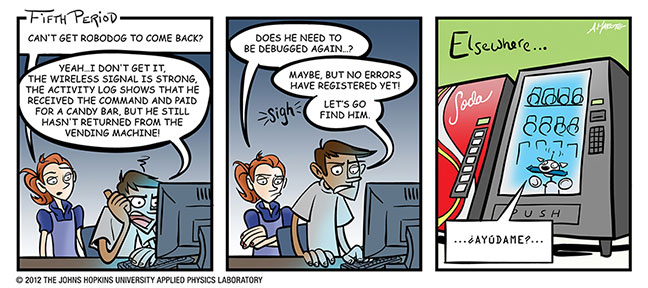
Tomás Command Center

Tomás is master of his domain in the computer lab! He's using his school's wireless Internet connection to send commands to his pet, Robodog! A wireless signal is a powerful thing: It can be used in many ways, which means you probably rely on wireless technology more than you realize (for example, when downloading things from the Internet). Nowadays, you can do things like record a video and send it to your friends as you are recording it, power the lights in your house with your phone (from miles away), and yes...even send a robot out to get you a midafternoon snack.
Think about it!
It seems like these days, as long as it has an on/off switch, anything can be controlled wirelessly. Think: What would be something really cool that you could control wirelessly? How would you use it?
January 18, 2013
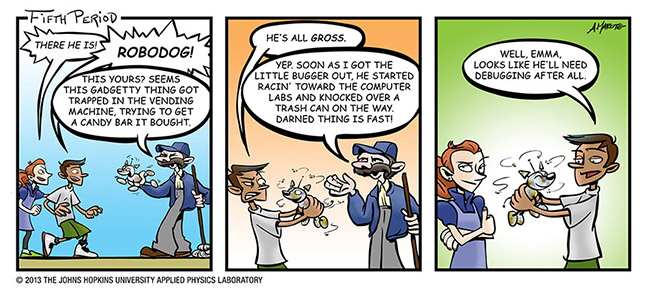
Robodog Reboot

Well, thank goodness there was nothing wrong with Robodog's programming and that he was only stuck in the vending machine! Otherwise, Tomás would have to go in and correct Robodog's code, which is the set of written instructions stored in Robodog's memory that makes it possible for the little guy to operate. (Tomás is able to do this with the help of another computer that's connected to Robodog's memory.) Going into the code and correcting mistakes is a process called debugging. Code mistakes (called bugs) can cause devices to behave really strangely, or not work at all! Robodog may have real bugs, but at least he's operating properly!
Think about it!
Tons of things use code to operate, including your favorite video games (on the console or on your personal computer)! Next time you're playing a video game, look to see if there's anything strange in the graphics. If you do see something, you've found a bug in the game!
February 1, 2013
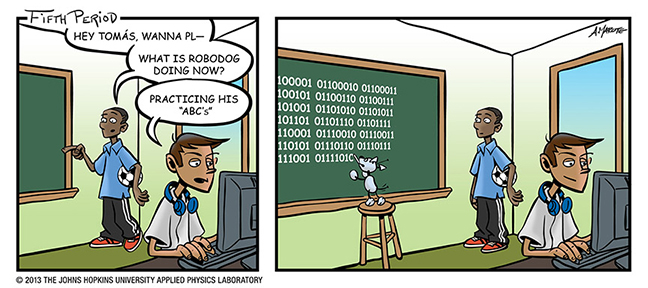
Robodog's Alphabet

Why do Robodog's "ABC's" look like a bunch of 1's and 0's? Because it's the language of machines! Robodog is writing in binary—the most basic way computers store, recognize, and use information.
Here's how it works: Computers are electrical, so they "see" information in terms of electrical charges. A "0" means there no electrical charge, while a "1" means there is an electrical charge. (In short, "0" means "OFF," and "1" means "ON"!) A 1 or a 0 is the very smallest piece of information a computer can process, called a bit. A set of eight bits is called a byte, and one byte can be used to represent one alphabetical character. You can rearrange the bits in a byte to make all of the different characters in the alphabet, as well as the full number set (0–9)! It may seem weird and wacky to encode all the characters we regularly use into just ON and OFF, but it's perfect for computers that operate at super-fast speeds!
Try it yourself!
You can learn more about binary AND encode your own messages with this binary translator.
February 15, 2013
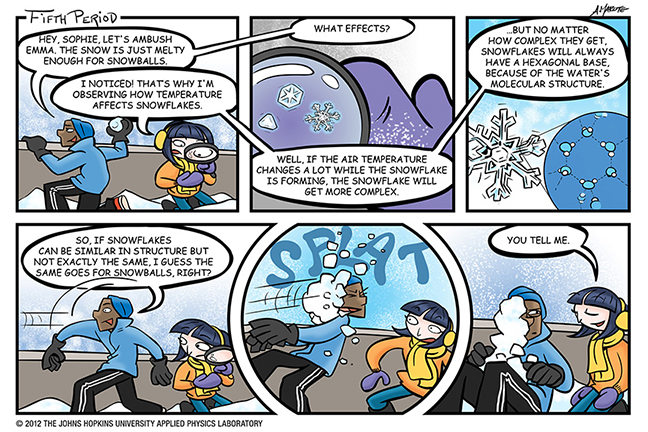
Sophie's Snowflakes

Everyone knows snowflakes—also called snow crystals by scientists—come in unique and beautiful shapes. But did you know that snowflakes get their fantastic designs because of a unique property in water? A water molecule—which is made up of two hydrogen atoms and one oxygen atom—is polar, meaning its two ends have different charges. Hydrogen has a positive charge, while oxygen has a negative charge, and when a bunch of water molecules are together, opposites attract! The hydrogen atom of one water molecule will pair with the oxygen atom of another. If the temperature drops low enough, they'll freeze in this position, forming the crystalline structure of snowflakes.
Check out this video to find out more about how snowflakes form.
...and to learn even more, check out NOAA's website on winter weather!
Try it yourself!
Because of changing air conditions, snowflakes will form into several different basic shapes. Next time it snows, grab a black piece of paper or cardboard and then head outside with a magnifying glass. How many different basic snowflake shapes can you identify?
March 1, 2013
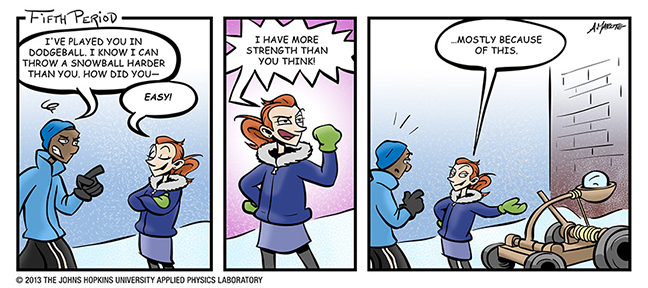
A Simple Win for Emma

How was Emma able to throw a much larger and faster snowball than reigning dodgeball champ Marcus? What is it about a catapult that makes it such an effective snowball-launching device? The answer is simple—simple machines!
Simple machines are mechanisms that affect the force of an object—meaning they can change how something moves (or doesn't move)—and there are a few different kinds:
An incline plane is any flat surface at an angle. Moving objects down an incline plane is easier because gravity is helping too.
A wedge is two incline planes fused together that can widen any gap if driven into it. A knife is a very shallow wedge that splits food apart.
A screw is a special kind of incline plane; it’s a very long and thin plane wrapped around a lever. When the lever is turned and pressed down into a surface, the plane wedges underneath the material, keeping the lever from pulling out.
A lever is anything you can pivot on a point (called a fulcrum) to pry something loose or tie something tighter. A crowbar is an example of a lever; you can push down on one end and the other end will push something up.
A wheel & axle is a rounded plane that rotates around a lever, and can carry anything attached to the axle across any distance.
A pulley is essentially a wheel that, instead of moving distances, pulls a cord around itself. It's usually used to raise or lower something on the other end of the cord, like the line on a fishing pole or the flag on a flagpole.
Try it yourself!
Simple machines are everywhere. How many simple machines can you identify in Emma's catapult?
March 15, 2013
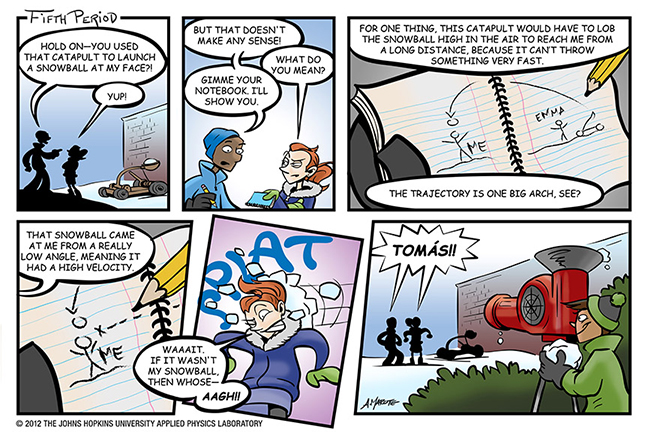
Marcus and Emma Go Ballistic

Marcus is pretty observant about trajectories—probably because of all his dodgeball experience! He knows that kids who can’t throw the ball very hard have to aim high to reach a target that’s far away, in order to account for the pull of gravity. Tomás’ pitching-machine-launched snowball had a high velocity, so he could aim much lower and still reach Marcus, even though he was just as far away as Emma when she launched her catapult toward Marcus.
Try it yourself!
With snowballs or a baseball and a friend, find out how high (or at what angle) you have to throw it to reach the greatest distance! Whether you realize it or not, you’re learning about ballistic trajectories and parabolas (an arced path)—the stuff home runs (and snowball fights) are made of!
April 5, 2013
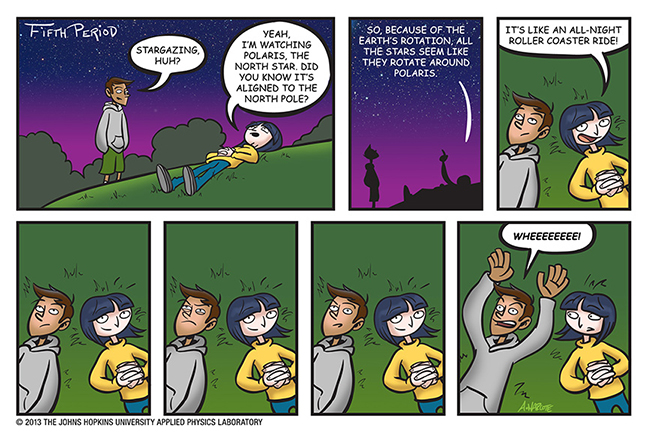
Sophie's Starry Night

Is Tomás a little bored while on his thrilling cosmic ride? Well, with moons zipping around planets, planets zipping around suns, and suns zipping through galaxies while those zip through the universe, it’s a wonder we all aren’t a little dizzy.
Surprisingly, even with all this zipping, we earthling riders have the northern pole star (more commonly known as the North Star) to help let us know where we are here on Earth after dark. Even though we are all moving through space at amazingly fast speeds, the North Star appears stationary because it is so far away and almost directly in line (or collinear) with the Earth’s axis of rotation—the imaginary line through both the North and South Poles. All other stars, including our own Sun, appear to move in great arcs around it because of the spinning of Earth on its axis of rotation.
That means that if Sophie and Tomás journeyed to the North Pole, the North Star would be directly above them (or at zenith) all the time. And if they decided to explore Brazil—taking a moonlit canoe ride on the Amazon River—the North Star would be at the horizon all night long (and all day long, too, for that matter). But for most of the rest of us, the North Star is somewhere in between, but always just as stationary, just the same.
Hey, but wait! What about all those people below the Equator in the Southern Hemisphere—how do they know where they are? They can’t see the North Star because it will always be below the horizon, right? Well fortunately for them, they have a star constellation called the Southern Cross that works for them the way the North Star works for us, only it helps them find South. For someone at the South Pole, the Southern Cross will be directly above them, while someone near the Equator will see both the North Star and the Southern Cross on opposite horizons at the same time! How cool is that?
Try it yourself!
You can observe the rotation of the Earth at night by stargazing too. Find a constellation that you're familiar with, like the Big Dipper, and note where it is in the sky in relation to a tree line or the outline of building. You don't have to stay there all night, but come back a few hours later and see if your constellation is in the same place!
April 19, 2013

Up, Up, and Away!

What was Tomás thinking—a jetpack over a quadrocopter??? Wait a second—what the heck is a quadrocopter? And why is it the best choice for your average science lab flying mission? A quadrocopter is an aircraft that has four rotors (horizontally mounted propellers) and operates on the same principles as a helicopter. The four rotors balance one another to make it very stable, while also giving it a lot of lifting power. Tomás could have taken advantage of a quadrocopter’s stability, allowing Robodog to hover and move gracefully through the science lab instead of blasting off in only one direction. Much easier on beakers and flasks, too!
Check it out!
There are lots of cool things that people are doing with remote-control quadrocopters. With a camera attached, they can be used to take pictures and video in the most unlikely places. People are even programming controls that allow two or more quadrocopters to work together. You can check out quadrocopters juggling a ball, working together to score a basket, and doing many other cool things here!
What would you attach to a quadrocopter in order to do some cool task you couldn't normally accomplish on your own?
May 3, 2013

Marcus Puts the Spin on Force

How is Marcus able to turn a bucket of water over his head without getting soaked? The same way someone can throw a ball over his head without it dropping on him. Objects that are moving want to keep moving in a straight line. Because gravity acts on objects all the time, though, they will follow an arc as they travel through the air on their own. If they move very fast, the arc looks almost straight, and if they move slowly, it looks more...archy.
In this case, Marcus uses the bucket to pull the water toward himself to make the water go around in a circle instead. The faster it goes, the harder he needs to pull toward the center (called a centripetal force) to keep it moving in a circle. Unfortunately for Mr. Kepler, the bucket handle breaks when it’s Emma’s turn, and both the water and the bucket “go ballistic” (remember that?) following the arced path instead...that leads to his head.
Try it yourself!
Next time you’re at a playground, take a spin on the merry-go-round. Notice how you need to pull yourself toward the center to keep your body going around in a circle, and you have to pull harder the faster you spin? You’re using centripetal force!
May 17, 2013
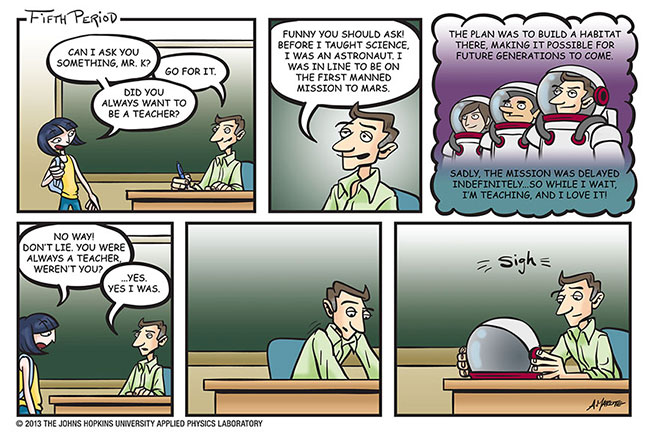
Mr. Kepler's Dream Job

Mr. Kepler may or may not be able to make it to Mars in his lifetime, but there’s still a lot of groundbreaking space exploration and exciting space research going on right now. At this moment, scientists are studying space from Earth’s orbit with things like satellites, space balloons, and the International Space Station! New discoveries are being made all the time, and you can be a part of it. Who knows, maybe a trip to Mars is in your future!
Think about it!
Learn more about some of the incredible spacecraft that are exploring our solar system right now, like MESSENGER (in orbit around Mercury, our solar system’s innermost planet), New Horizons (currently cruising toward Neptune on its way to study Pluto, its moon Charon, and the Kuiper Belt), and the Van Allen Probes (two probes that are studying the Earth’s radiation belts to help us understand how the Sun affects our “space weather”). If you were a space scientist, what would you study?
June 7, 2013
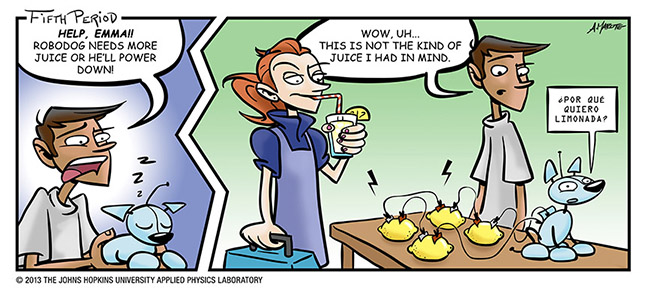
Sour Power

Let's put aside for a moment that Tomás should have a power adapter at the ready to recharge Robodog. The big question is, why on earth did Emma wire the gang’s faithful mechanical canine to a bunch of lemons?! Well, lemons are full of citric acid (that's what makes them so sour!), and an acid can actually be used to generate electricity.
Try it yourself!
You can make a lemon battery using a couple of juicy lemons, a few household items, and some common electrical tools (that your parents may have or that may be available in your school’s science lab). Your lemon battery won’t have enough voltage to power a robot dog, but it can be used to power an LED light!
Each lemon can be thought of as a little hill, providing enough incline (or potential) to move a little ball a short distance. The little ball is like your electrical current. If you put a lot of hills together in series (one right after the other), all of these hills can work together to roll a ball a long way. Each lemon battery provides a little bit of electricity—or more correctly, electrical potential. When combined in series, that potential is enough to power a low-light LED for a time.
There are other ways to wire your lemon battery, but that’s a discussion for another day. For now, enjoy the lemonade!
June 21, 2013
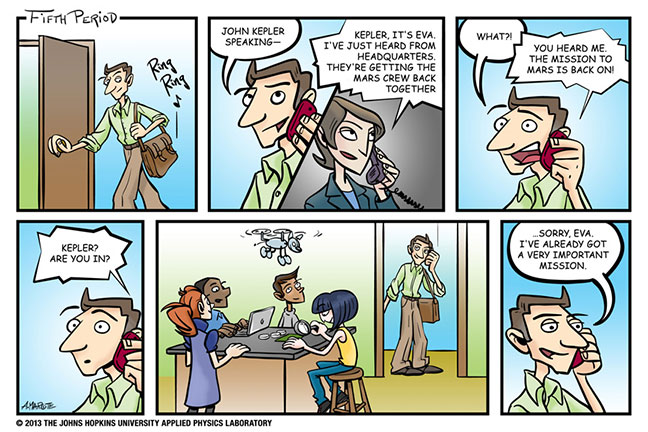
School's Out!

Sophie, Tomás, Emma, and Marcus have had their fair share of adventure this year—now it's time for them to go on summer break. The gang definitely won't be sitting around while they're on vacation, though, so come back this September to see what they’ve been up to. There are plenty of new adventures to come!
Very special thanks go out to the APL STEM Office, Anne S., Don, Kal, Anne K., Frank, Jeff, Jon, and many others for all of their help making this webcomic possible.
September 6, 2013
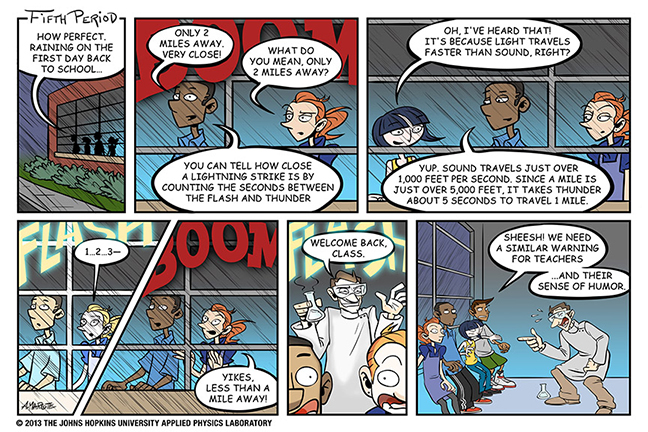
Mr. Kepler Strikes Again

It’s true! Sound travels slower than light. We see light almost instantaneously because light travels so fast (186,282 miles per second!). But sound is actual oscillations (movement to and fro) of a fluid, like air, so it takes longer to get to us. Marcus actually knows that the speed of sound is 1,126 feet per second and that a mile has 5,128 feet. But since he is a master estimator and knows what to do to make quick calculations, he rounds both those numbers down to 1,000 feet per second and 5,000 feet. No storm will ever surprise him! Mr. Kepler’s “shocking” prank on the other hand...
Try it yourself!
Next time a thunderstorm rolls in, count the seconds between the lightning flash and thunder. Just remember, if you can hear thunder, a lightning strike is close enough to hit you, so stay inside!
Also, if you are lucky enough to visit a quiet canyon or someplace like that, try shouting across it. Time how long it takes to hear your echo with a stopwatch—if you multiply the number of seconds by the speed of sound (1,126 feet per second), you can get an approximate distance to the other side! But wait—the echo you hear has had to travel out and then travel back—twice as far. So you have to take the time times the speed of sound, and then divide that by two to get the distance to the other side. A similar thing happens with radar, but that’s a problem for another week!
September 20, 2013
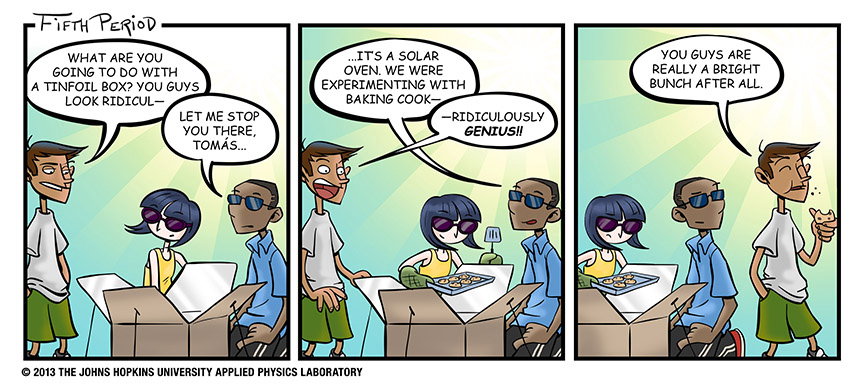
Tasty Solar Power!

Sophie and Marcus know sunlight can do more than just brighten your day or give you a nasty sunburn—it can also be used to cook! Since the 1700s, people have been experimenting with converting sunlight into powerful heat. Sunlight is actually electromagnetic radiation, or waves of particles called photons. Sunlight isn't hot, but when photons pelt the atomic particles of another substance (like water, or maybe cookie dough), they cause those particles to vibrate faster—heat! When you focus the sun's rays with reflective material like tinfoil, you're increasing the amount of photons that pelt a substance, causing it to get hotter faster than it can cool—in this case, hopefully fast enough to keep up with Tomás' appetite! You'll probably want to learn more about how solar cooking works, too.
Try it yourself!
Want to harness the natural energy of the sun? You can build your own lightweight solar oven using just a few household items. Try warming up some leftover soup first, and then try other foods once you know how hot your oven gets (to figure that out, get an oven thermometer from your parents). It will take longer than a regular oven, but you aren't using any electricity to make something really tasty.
October 4, 2013
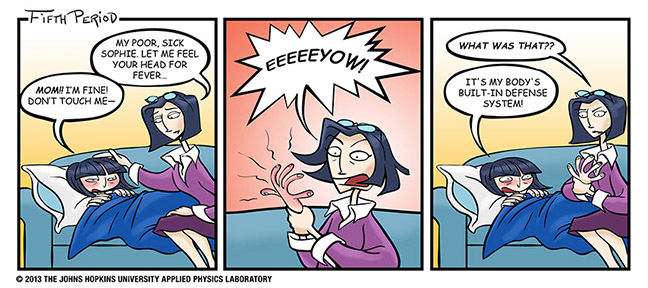
Sophie the Scorcher

That is some fever Sophie has—school is out of the question for her today. Flu season will be here before you know it, so it's a great time to learn about the amazing ways your body responds to infection. While a fever could never get hot enough to burn someone else (if it does, you might be a superhero), some people believe it does get hot enough to make it harder for bad microorganisms to grow in your body. However, if a fever gets too high, it can actually damage your organs. Ouch!
Fevers are a sign that your body's defense system is working! They are caused by the complex interactions of chemicals released by your white blood cells. When a white blood cell “sees” a pathogen like a virus or bacterium, it releases chemicals into your blood to communicate to other helpful disease-fighting cells. The presence of those chemicals in your blood tells your brain to raise your body temperature, and—voilà—you have a fever.
Think about it!
What's the highest fever you've ever had, and what were you sick with? Does a higher fever correspond to a more severe sickness? Is your body working harder to defend itself?
October 18, 2013
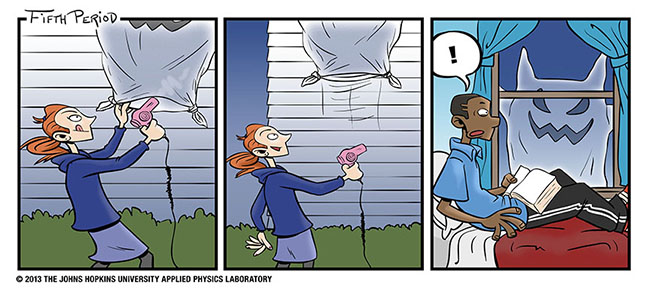
Hot Air Halloween

What the heck is going on here?! What is Emma doing outside with a hair dryer? It looks like she’s steamed up a simple plot to give Marcus a cheap scare, and all it took was a little thermodynamics! Emma knows that the hot air from the hair dryer is less dense than the cold October air. That’s because the molecules in hot air are moving around faster and more erratically than air at a lower temperature, meaning the molecules are farther apart and thus less dense. Fluids of a lower density will always rise above higher-density fluids. (Fun tip: have you ever tried to mix vegetable oil and water? See which fluid is less dense.) All Emma had to do then was find something to trap the hot air. Lucky for her, she had a ghostly looking trash bag to spare. After blowing hot air into it, she simply let it float up to Marcus’s window and—bingo—Trickery Accomplished!
Try it yourself!
You can make your own hot air spook for Halloween. All you need is a very thin plastic bag, a hair dryer, and perhaps markers or construction paper to put a scary face on the bag. After drawing or pasting some eyes and a mouth on the bag, check to make sure there are no holes. Tie the edges of the bag’s open end into knots to make the opening smaller (so the air stays trapped). Then grab a hair dryer, fill the bag with air (taking care not to touch the plastic bag to the heating element in the dryer), and watch your ghostly creation float into the night.
November 1, 2013
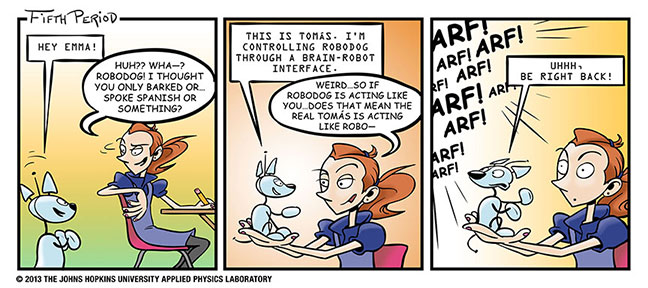
Robodog Takeover!

Robodog is one special toy robot—Tomás has figured out how to control him with brain power. Most robots (mechanical devices capable of doing complex tasks automatically) require some kind of input in order to work—usually programming. These days, however, clever scientists and engineers have figured out how to convert brain and nerve signals (you know that's your body's own electricity, right?) into inputs that robots can use! It's the main concept they're using for the next generation of prosthetics.
Prosthetics are artificial limbs for people who have lost them due to injury or sickness. Nowadays, prosthetics can be robotic, and some are actually controlled with our brains. Check out this video of an actual patient controlling a prosthetic arm using a brain–computer interface. Pretty cool, right? Although it's highly unlikely that someone could "switch brains" with a robot they are connected to via brain–computer interface (like Robodog and Tomás), scientists are actually thinking of ways that a prosthetic limb can provide sensory feedback to a user, in a way that can help them "feel" again.
Try it yourself!
You can make your own "robot" hand with stuff around the house. Granted, it's not going to replace your real hand, but it can be a neat tool for grabbing things or scaring people. In this case, the input is the movement of your own hand. So, grab an adult to help, and start building!
November 15, 2013

Tomás the Robot?

Where humans go, robots are soon to follow—sometimes they even get there first! Tomás is understandably jealous of robots—some, like the Mars and lunar rovers, have traversed miles and miles of extraterrestrial worlds, and have been doing so for decades. Scientists have been sending robotic instruments into places that people can’t currently go, whether it’s to space or the deepest depth of our oceans. So much of what we know about our world and beyond is thanks to robots!
The sky’s the limit for Tomás if he continues to mind-control Robodog…but he should probably make sure Robodog doesn’t wreak any more havoc with his human body.
Try it yourself!
Do you or your parents have the program Google Earth on a home computer? If so, you can actually "visit" the Moon, or Mars, and follow the same paths that astronauts and rovers did. If you don’t have Google Earth, get an adult to help you install it—it’s free!
December 6, 2013
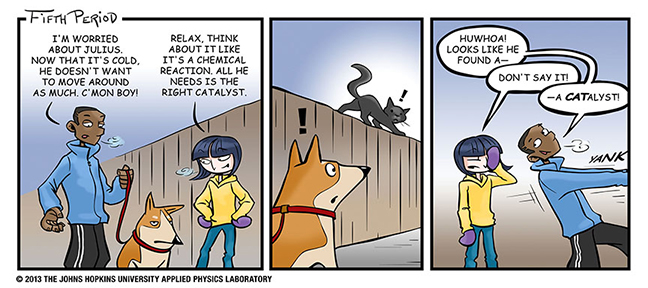
Cat and Dog Chemistry

Marcus' canine pal just needed a little persuasion to get moving, and there's nothing like a cat to perk him up. In the same way, chemicals known as catalysts can get chemical reactions moving along at a quicker pace. A catalyst is a substance that increases the rate at which a chemical reaction occurs, without changing its own chemical makeup. Why is this important? Sometimes chemicals don't react as well when subjected to less-than-ideal conditions (like cold) and need a little push. Also, when a catalyst is used in a chemical reaction, less energy is required to start the process in the first place. This is especially important for factories that produce things like plastics in bulk—think of all that energy saved! So, now that Julius the dog has found a cat to chase, Marcus has to spend less energy trying to get him up and running around. Perhaps he could use that saved energy to think of some better jokes!
Try it yourself!
Want to see a catalyst in action? Check out this video and learn how to make “elephant toothpaste.” In this experiment, dry yeast (a baking ingredient) is the catalyst used to help release oxygen from hydrogen peroxide. Hydrogen peroxide (H2O2) naturally breaks down into water (H2O) and oxygen (O2), but this breakdown happens really slowly without help. BUT, when you add yeast to the mix, as well as a bit of dish soap to trap the released oxygen, you get something crazy. So grab an adult to help, and try it yourself!
December 20, 2013
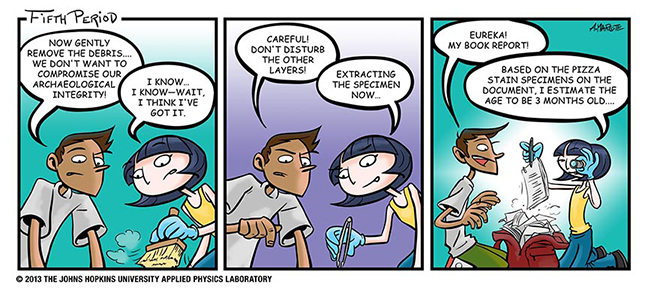
The Homework Expedition

When Tomás is in danger of losing credit for an assignment, it’s time to get digging! Figuring it got buried in the depths of his backpack, he enlists Sophie’s help to uncover it with archaeological precision—they can’t do anything to the paper that would call into question its originality! Believe it or not, the layers and layers of scrap paper that Tomás has accumulated are much like sedimentary rock! Why? Because sedimentary rock (one of the three major types of rock—the others are igneous and metamorphic) forms when deposits of rocks, sediment, and soil build up over long periods of time.
Just as Sophie was able guess the age of the undated book report by looking at the (probably really gross) pizza stains on it, geologists who study sedimentary rock in the Earth’s crust use fossils buried in the rock to determine its age. They take studying these rocks very seriously because they contain clues about Earth’s history!
Just think about it!
What are the places around your home where you can use a similar technique to determine the age of an object? Do things in your fridge get pushed back as new things are added? Think about games, movies, toys, and clothes—can you figure out which things you like most based on their placement in the pile?
January 3, 2014
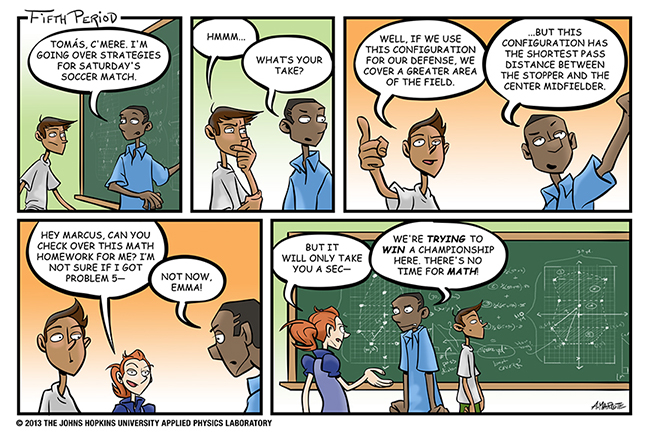
A Real Mathlete

Sometimes we’re so good at something we hardly realize we use it so often. Marcus thinks he doesn’t have time for a little math homework, but he’s just spent a whole afternoon analyzing the geometry of soccer formations! Maybe you don’t painstakingly map out soccer positions to figure out the best formation to use because it covers the most area or whatever, BUT you probably are constantly doing little equations in your head!
Think about it!
What if your mom or dad asks you to go to the grocery store to get something, and the store closes in 30 minutes. You know that the store is 2 miles away and that you can ride your bike about 9–10 miles per hour, so you probably know whether you can make it there in time!
Or, maybe you’re making a cake that needs 4 cups of flour, but you only have 3 cups on hand. Since you only have three-quarters of the flour, you can figure out what three-quarters of the rest of the ingredients are and scale down the recipe…or you could just ride your bike to the store that’s only 2 miles away like your mom or dad asked you to!
What are some ways you use math without really noticing?
January 17, 2014
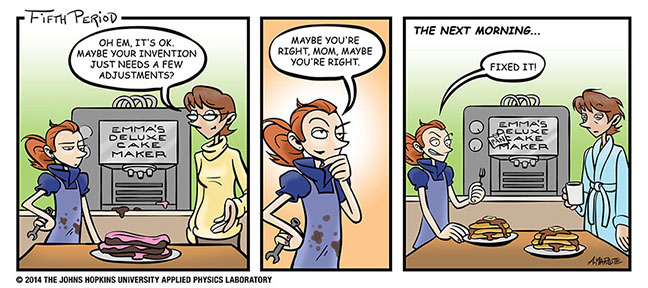
Emma’s Engineering Accident

Emma is quite the opportunistic inventor—when her automatic cake-making venture didn’t pan out, she saw it as a happy accident and figured out that her machine could do something much simpler (with an equally delicious end result): pancakes! This is hardly a half-baked way to engineer something; in fact, a lot of notable inventions were discovered by accident. Think about the microwave—it’s something almost every home has these days, but those little machines actually have their roots in World War II radar technology. Can you believe the same technology you’ve used to pop popcorn was once used to find enemy submarines?! All it took was for brilliant machinist Percy Spencer to notice something weird when he walked in front of a magnetron. Read more about the discovery.
Think about it!
Learn more about other accidental inventions like Velcro, safety glass, matches, x-rays, pacemakers, and even Post-it notes. How many of these things do you use every day? How would your life be different without them?
And the next time you’re working on something and things don’t turn out quite the way you expected, don’t be too quick to start over or give up—instead, think about whether what you ended up with could be applied to something else. Your “mistake” might end up changing the world!
February 7, 2014
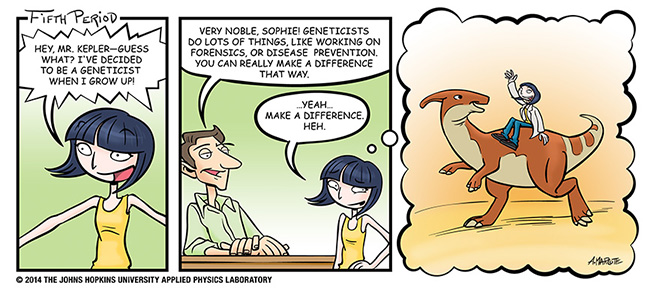
Curiosity Is in Her Genes

It's true! Geneticists are making a difference every day, whether it’s working with forensics to solve mysteries, helping to develop stronger crops for agricultural use, or finding out what causes genetic defects. How do they do this? Geneticists are scientists who work to unlock the secrets of the human genome—the entirety of human genetic information, housed in our DNA (that makes us who we are!)—as well as the genomes for many other species. By studying gene sequences, geneticists can uncover which genes are responsible for which traits in a species, or which genes have mutated! There’s still a lot more to be learned from our genes because they contain much of the same genetic information passed on from our ancestors over many, many, MANY years....
And speaking of ancestors...
Check it out!
As we learn more about genes and how they work (thanks to geneticists), more researchers are pushing the boundaries of what they can do. Read about how one researcher plans to reverse-engineer the genes of a chicken to create a dinosaur! Just as we possess the same genetic information as our ancestors, other species—like birds—contain the genetic information of some very large creatures that roamed our planet a looooong time ago. Could a pet dino be in Sophie’s future?
February 21, 2014
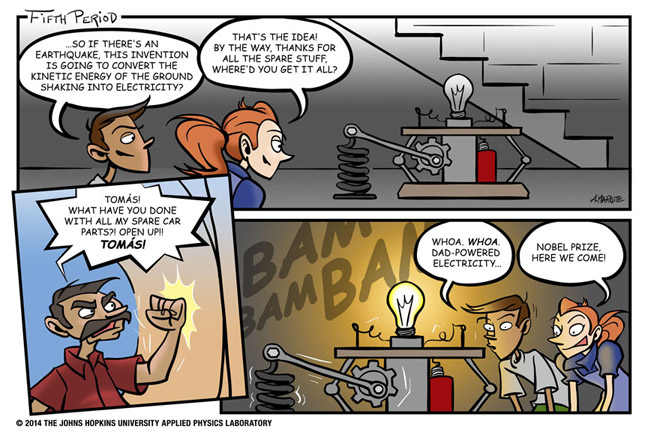
Dad Power

Have Tomás and Emma stumbled on a new alternative energy source?! Little does he know, Tomás’ dad has unwittingly contributed his kinetic energy to be harvested by Emma and Tomás’ spring-loaded…gear…thingy. They figured they might be able take energy from a ground-shaking earthquake and capture it in a spring, which would then turn gears that generate electricity—but they didn’t bargain on an earthquake so soon! Emma and Tomás’ contraption may not work in real life, but the idea isn’t as far off as you would think. Did you know that scientists are exploring the concept of volcano-powered and wave-powered electricity? It turns out electricity can be generated in some surprising ways!
Try it yourself!
A while back, you learned how to make a lemon battery that could put out a tiny bit of electricity. But now you can harness your own kinetic energy to light an LED bulb. So check out this tutorial on how to make a “shaky generator”, grab an adult to help, and get shaking!
March 7, 2014
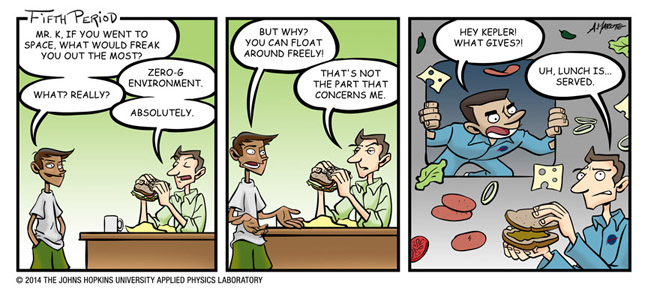
Out-of-This-World Lunch

Have you ever wondered what it would be like to eat—or…do anything—in orbit around Earth? Whatever it is, the zero-G (or microgravity) environment of space makes it much more interesting! Luckily for Mr. Kepler, he need not worry about his sandwich floating apart (regular astronaut fare doesn’t include sandwiches), but it would if he had forgotten toothpicks to fasten the ingredients together.
Actually, Mr. Kepler and his sandwich ingredients (and the whole spaceship around them) aren’t floating so much as they are falling—really, really, REALLY fast. That’s what happens when something is in orbit around the Earth. Usually, when a projectile (like a spaceship) is launched away from Earth, the planet’s gravitational pull will bring it back down if it’s going too slow. If the projectile is launched too fast, it can break free from the gravitational pull. BUT, if you time it just right, the projectile will be going just fast enough NOT to be pulled back to Earth, but unable break free! How does this work? You can learn more about orbits here and more about microgravity here.
Check it out!
Get a glimpse of what life is like in orbit around the Earth. Join astronaut Chris Hadfield as he attempts to make a burrito in space! It just goes to show, microgravity shouldn’t be taken lightly!
March 21, 2014
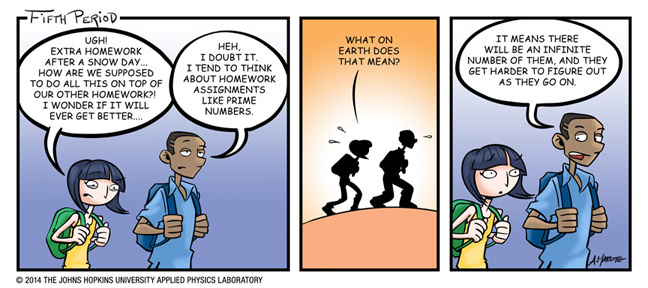
Prime Time for Marcus

Don’t worry guys—the homework will stop one day, but the prime numbers won’t. Prime numbers are so much more than weird, indivisible numbers that go on forever though—some of their properties make them extremely useful for cryptography. You probably already knew that a prime number is only divisible by 1 and itself (for example, 13 is a prime because it can only be divided by 13 and 1) and that these numbers get further apart as they get larger (…5, 7, 13, 17, 23, etc.). Mathematicians believe that all numbers in the universe are composed of prime numbers. As numbers get larger, it gets harder and harder to break them down into their prime number parts. By the same token, it gets harder to determine whether a number is a prime as it gets larger. This property of prime numbers is part of number theory and makes things like Internet encryption possible—the kind of thing that allows your parents to pay their bills online and not worry too much about computer hackers!
Think of encryption this way: Say you have a computer file protected with multiple passwords—in this case, the passwords are prime numbers. You can open the document because you know the passwords, but a hacker must try all sorts of combinations to get access to all that private information, and he’ll likely write fancy software algorithms to get his computer to try all those combinations. If the prime number passwords are smartly chosen, the hacker has almost no chance of getting access to your data, regardless of how incredibly smart or determined he is.
Try it yourself!
There’s a simple, visual way to determine whether you have a prime number of any group of objects. Take for instance a bag of candy—can you arrange the pieces into a rectangle of any size, with columns that have the same number of pieces? If so, you have a non-prime or “composite” number, but if you have a few pieces left over, you have a prime number. BUT, are you really, really sure? Can you rearrange the pieces with a different number of columns and rows to get that perfect rectangle shape?
Now, imagine having to do this with hundreds and hundreds of candy pieces—a nearly impossible task, or at least very hard, even using a computer! For large numbers, there are lots and lots of combinations that must be tried!
Just a glimpse of how prime numbers’ mysterious nature makes them perfect for encryption purposes.
April 4, 2014
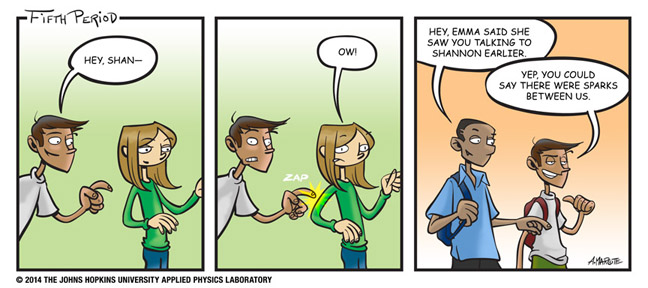
Shockingly Smooth

What is Tomás really doing, besides striking out with Shannon? He’s actually transferring his extra electricity to her. You see, all matter—like our bodies—is made up of atoms, which are made up of smaller particles called protons and electrons. (There are actually more types of particles than just those two, but that’s a topic for another strip!). Protons, which are at the center (or nucleus) of an atom, have a positive charge. Electrons, which orbit the nucleus, have a negative charge. Running down the hall, Tomás probably picked up a few extra electrons from the friction of his feet on the floor, giving him an overall negative charge. When he comes in contact with Shannon, who is now more positively charged than he is, his extra electrons “jump” to her to equalize the imbalance, creating a spark!
Try it yourself!
Tomás demonstrated that things with opposite charges will be drawn to one another. Sometimes that attraction can be strong enough to move the entire object, if the object is small enough—like when your hair will stand on end after you rub it with a balloon. To create your own static electricity “magic,” get a plastic spoon and some salt. Vigorously rub the spoon on some cloth, and then hold it over the salt to see it “jump.” Keep trying this with bigger and bigger objects, like paper pieces, to see how large an object can be and still be moved by static electricity. But maybe don’t try it on your crush, OK?
April 18, 2014
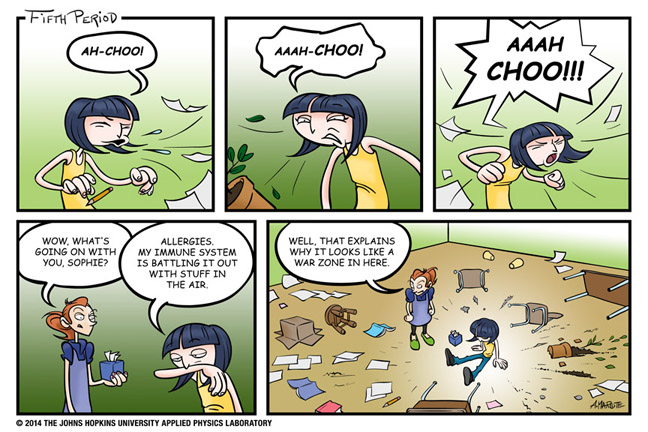
It’s Not Easy Being Sneezy

Remember when Sophie got the flu? Well, the same forces are at play here, except this time, Sophie’s immune system has got it all wrong! Allergens—normally harmless particles of stuff, like tree pollen or dust—are the cause of her woes. Sometimes our immune systems get confused, and our white blood cells treat allergens like pathogens (viruses and microorganisms that actively attack the cells in our bodies). Because of this, allergy symptoms can be similar to the symptoms of an infection—as Sophie can tell you, the sneezes from her allergy are just as powerful as the sneezes from a common cold!
Think about it!
So, if your immune reacts the same way to allergens as it does to pathogens, and can give you the same symptoms (like cold symptoms), how can you tell a cold from an allergy? Consider these things:
Did you catch it from someone? Although two people can have the same allergy, you can’t spread an allergy like you can an infection!
What time of year is it? Are you sick during cold season, or is it spring, when all the trees and flowers are releasing their pollen? (Pollen is a common allergen.)
How long have you been sick? Allergies will affect you as long as the allergen is present, and that could be a very long time! As nasty as a cold infection can be, it will go away after a few days.
Want to know more? Read up on the science behind allergies to learn about the complex reactions that trigger them.
May 2, 2014

Get Real, Tomás!

Ahh, to see the world through Tomás’ eyes! It looks like he got ahold of a virtual reality (VR) device that creates a projection on top of the real world. He can explore this virtual world because it completely encompasses his field of vision, making it a fully immersive experience. If only Marcus knew!
It may seem futuristic, but scientists and technologists have actually been working with VR technology for many years. In fact, VR has some very important applications today: Check out these British soldiers learning how to parachute using VR. They get the same experience (sort of) but with 100% less danger! And it doesn’t stop there—the same technology is used to train soldiers in combat tactics.
Of course, VR is also great for being creative! Video game developers are embracing VR for the next generation of gaming—have you heard of the Oculus Rift? Pretty soon, everyone could have access to immersive cyber worlds!
Think about it!
If you could create a virtual world, what would it be like? What kinds of things would you be able to do? What dangerous or difficult task could you teach using VR?
May 16, 2014
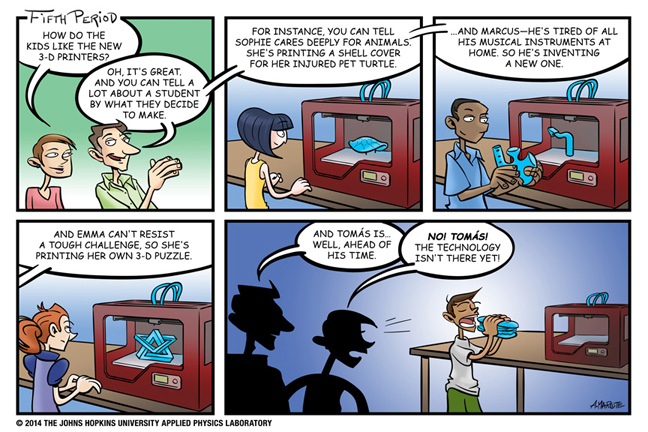
Printing in a Whole New Dimension

It’s true—you can print just about anything in three dimensions now, using a process called additive manufacturing. If you have a computerized 3-D model of something (machine parts, action figures, fashionable shoes, etc.), a 3-D printer will be able to recreate it. Hold on though—someone didn’t tell Tomás that, while the objects are 3-D, they aren’t the real thing! 3-D printers these days use mostly plastic material or metal powders to “build” the objects—these materials can be melted by the printer and quickly hardened again. The printer deposits the material in layers, and you can see the object grow as more layers are added!
That’s where it starts to get interesting, though: Some people realized that if there’s a material that will melt easily and then resolidify, it can possibly be used to print with! Now they’re experimenting with more unusual materials like chocolate, sugars, textiles, and even biomatter! 3-D-printed organs, anyone?
Check it out!
If you can dream it up, you can print it. See 3-D printing in action here. If your school or home had a 3-D printer, what would you build?
June 6, 2014
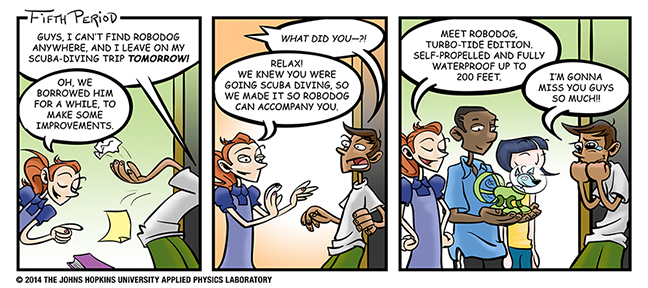
Summer, Here We Come!

The school year is finally over for the Fifth Period gang, and it looks like they have a lot planned for the summer. Don’t worry though—they’ll be back next September with more stories to tell. Now it’s time to go see what summer has in store for you!
Very special thanks go out to the APL STEM Office, Anne S., Don, Kal, Anne K., Frank, Jeff, Jon, Lynn, and many others for all of their help making this webcomic possible.
October 10, 2014
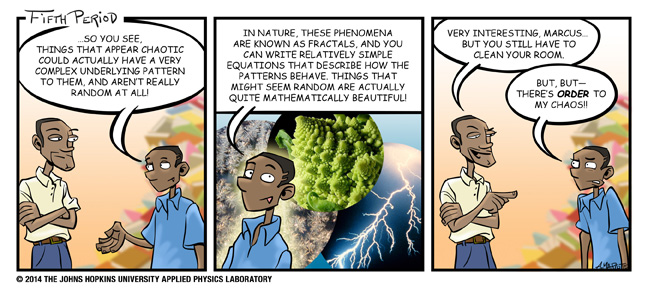
Marcus's Perfect Mess

Welcome back to Fifth Period, everyone! Summer vacation is over, and the gang is ready to get back to school. Poor Marcus, though—looks like he’s got a lot to take care of first. It’s hard to imagine there’s anything interesting about a bedroom with a big ol’ random mess.
Or…COULD there be something interesting in all the randomness? Is there something that lies beneath the mess? (Besides, you know, dirty socks…) To find out, we can look at nature, which is like the biggest exercise in randomness ever—and YET, amazing patterns pop up everywhere. Ever notice how the veins in a leaf branch off in a predictable and orderly fashion? Or, if you’ve ever been on a plane and had the chance to see a mountain range from up above, do you see how the mountains look smaller and smaller at the edges of the mountain range but still have the same shape as bigger mountains?
These are all examples of fractals, or patterns of shapes in which the individual shapes have the same characteristics as the whole dang pattern—even as they get smaller and smaller! What’s crazier is that we can use math to predict what these patterns will look like, even as they go on forever.
Try it yourself!
What fractals in nature do you think you’ve observed? Extra challenge: Do you think you can describe the pattern mathematically? (For example, the veins in a certain leaf might branch off in twos, and are half the length of the parent vein.) To learn more about fractals, see examples, or even make your own abstract ones, check out the Fractal Foundation.
October 24, 2014
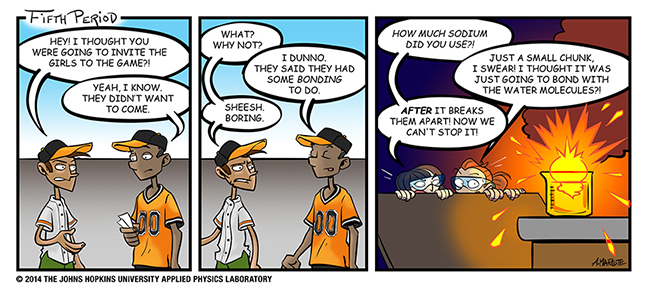
Bonding Time!

Tomás and Marcus really misunderstood the girls: bonding—chemical bonding, to be exact—is no little thing. In this case, pure sodium, one of the Earth’s most volatile solids, will bond with hydrogen and oxygen—which is what makes up a water molecule. Sodium’s tendency to bond with other elements is so strong, it will actually break apart water molecules just to get at that hydrogen and oxygen. The resulting decomposition reaction (remember those?) releases so much energy that it ignites the excess hydrogen gas created during the reaction. In short: BOOM! Observing such a fantastic display can be a great way to strengthen a friendship! (From behind a safety barrier with protective eyewear, of course.)
What exactly is happening at the atomic level, though? You may already know that atoms of any element are made up of protons, electrons, and neutrons—teeny-tiny subatomic particles. Protons have a positive charge, and electrons have a negative charge (and, as you probably guessed, neutrons have no charge!). Electrons will orbit the nucleus of an atom (which is made up of the protons and neutrons). Without going into too much detail, atoms of different elements will sometimes share or steal their electrons, depending on which element has the correct number of electrons in its outer energy shell. The resulting difference in electrical charge bonds the two atoms together—opposites attract, remember?
Check it out!
Learn more about how atoms bond. This video explains in more detail how atoms (like those of the element sodium) will swap electrons to form brand new molecules.
November 7, 2014
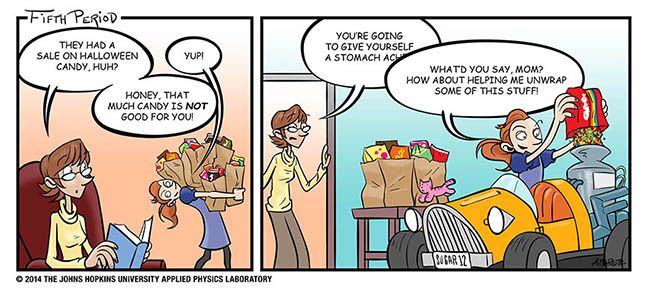
Emma Is Oddly Energetic

Unbelievable! Not only has Emma rigged up her own motor vehicle, she’s using a fuel unlike any other—candy! There’s no way this could work. Right? RIGHT?
Actually, it’s not as weird as you think. In fact, people have been generating power and fueling vehicles with some arguably weirder things. Like this Poo-Powered Rickshaw made by the Denver Zoo (for getting folks around the grounds). And also this Coffee-Powered Car made by British engineers (who knew coffee had THAT much pep?). One county in Florida is even generating power from trash!
What do these weird alternative fuels have in common? Well, some of them are WASTE, and all of them can be found in large quantities—so you don’t have to worry about running out anytime soon! While Emma’s fuel choice isn’t waste, it’s certainly in abundance this time of year, and who can pass up a good deal?
Think about it!
If you could run a vehicle on a fuel other than the regular ole’ fossil fuels we usually use, what would it be? Why would you choose that for fuel?
November 21, 2014

Loud and Crystal Clear

Tomás—never one to back down from a challenge—has heard about the myth that you can break a crystal glass using only sound…except, it’s not really a myth! It can be done! While this does take a bit of skill, Marcus is right: you don’t have to be a good singer, just able to hold a consistent tone of voice VERY LOUDLY.
How can that be done? All materials have a resonance frequency—a natural frequency at which all things vibrate—but the resonance frequency of crystal is easily observed. Just tap the crystal and listen to the beautiful tone. When you use your voice (to sing really badly, for instance), you produce pressure waves through the air: sound waves. How far apart those sound waves are from one another determines the pitch of your voice (how high or low it is)—that’s its frequency. If the frequency of your air-pressure waves matches the resonance frequency of the crystal, the crystal will vibrate on its own, producing a hum.
But what actually breaks the glass? Say you are already making sound at the correct frequency. If you increase your volume, you are adding energy (or amplitude) to your air-pressure waves. This will cause the crystal to vibrate even harder until…SNAP! The crystal breaks…or was that Marcus’s eardrums? Learn more about the physics behind breaking crystal with sound here.
Try it yourself!
We don’t want you to try and break your parents’ good crystal, but you can still experiment with the resonance frequency of crystal by wetting your finger and drawing it gently along the rim of the glass. Hear the sound it makes? Now, what happens when you fill the glass partially with water? Do you notice a change? Does the hum get higher or lower? Why do you think that is?
December 5, 2014
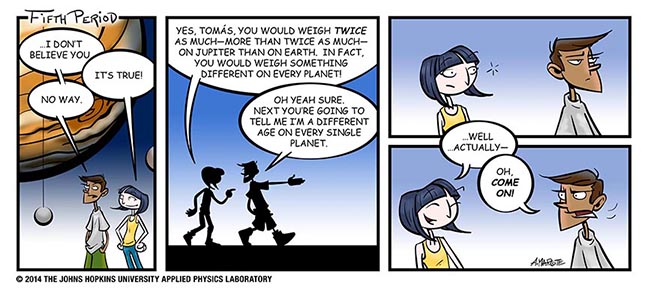
Gravity: A Weighty Topic

Tomás, like us, tends to think of his weight as something constant about himself. But Sophie knows better! She knows that while our mass is constant—that’s the amount of actual matter in our bodies—our weight depends on the amount of gravity acting on our bodies’ mass. We all know that gravity is what keeps us from floating off the face of the planet, but what is it really? You can think of it as an invisible force between two objects with mass. The more mass there is and the closer the objects are to one another, the stronger the force between the two objects. Now, your weight increases as gravity grows stronger…see where I’m going with this?
And…can you really be a different age on a different planet? Well, sort of. Remember that your age is based on the Earth’s orbit around the Sun. When the Earth makes one complete revolution around the Sun, you’re one year older, right? Now think about a planet like Neptune—it’s much MUCH farther from the Sun, so its orbit takes a LOT longer. In the time that Neptune takes to travel around the Sun (one Neptunian year), Earth has already traveled around the Sun many, many times.
Try it yourself!
This website will figure out what you weigh on other celestial bodies and teach you more about gravity in general. And if you’re curious to know how old you are in Jovian years, or Plutonian years, just enter your birth date on this website to see just how old (or young) you are, based on the orbit of any planet in the solar system! Also, see if you can figure out how old Robodog is in Jovian dog years!
December 19, 2014
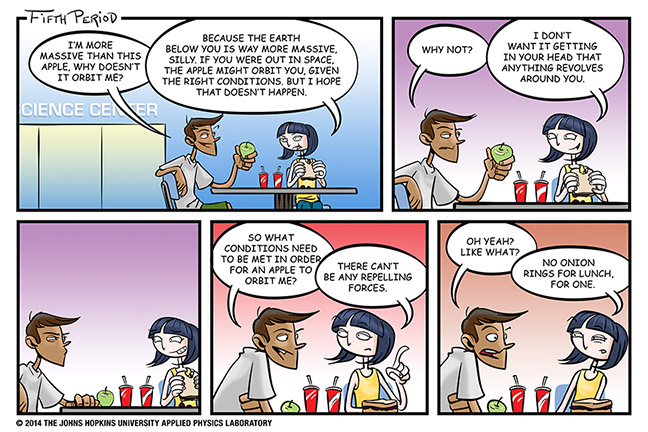
Orbiting Around the Idea

Looks like Tomás is starting to get creative with the idea of gravity! The thought of something orbiting Tomás (as small as he is on the cosmic scale) is not as far-fetched as you might think. We usually only think about the bigger things—planets and suns—that have things orbiting them, but did you know that something as small as an asteroid can have moons? Scientists have been able to find as many as 150 asteroids with such moons!
Let’s say Tomás was in outer space (properly outfitted in a spacesuit, we hope). Because Tomás has mass, he will exert a small (really small) amount of gravitational pull on objects near him. If an apple approaches him at a slow enough speed (hold on, why is there an apple floating in space?! oh, never mind), it won’t be able to escape his very weak gravity field. Remember when we talked orbits and microgravity earlier? Same concept! Keep in mind, though, that this is all highly theoretical. Just about anything could destroy this unlikely delicate orbit, bad breath included (if you could breathe in space).
Check it out!
Learn more about asteroids on NASA’s Solar System Exploration website. It’s possible for two or maybe even three asteroids to orbit around each other. If Sophie were to join Tomás on his theoretical adventure, they could orbit each other and share the limelight!
January 9, 2015
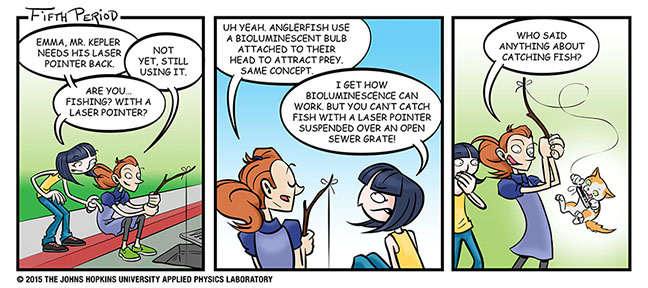
Shiny!!

We all like shiny things, and nature’s creatures are no exception. There are many life-forms—mostly sea life, like algae or squid or deep-sea fish—that exhibit bioluminescence, which literally means “living light.” Emma knows that certain furry, pointy-eared organisms are attracted to dots of light, and she uses the bioluminescent deep-sea anglerfish as the inspiration for her laser-pointer-fishing-rod thing. An anglerfish is just one example of a life-form that uses bioluminescence to its advantage. But life-forms glow for lots of reasons, like communication (think fireflies), defense, even camouflage!
The “living light” that makes a life-form bioluminescent occurs in a number of ways, depending on the organism, but for the most part, it’s caused by a chemical reaction where light is the by-product. Learn more about it here—no electricity required! That’s actually the part that interests engineers and scientists the most: they want to figure out how to produce “cold” light just like an organism, because it takes a LOT less energy.
Try it yourself!
If you’re ready for a more advanced experiment, you can actually grow your own bioluminescent algae. You’ll need to purchase one or two specialty products though, so grab an adult to help. If you give your algae enough care and attention, it will light up at night when you disturb it!
January 23, 2015
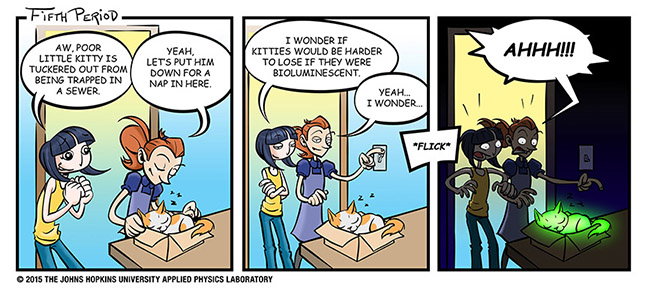
In Fur a Surprise…

A glow-in-the-dark cat?! How is that even possible? It’s not magic, believe it or not! Just when you thought the only bioluminescent creatures were insects or those living in the deep sea, it turns out even mammals can become bioluminescent—with the power of genetic engineering, of course.
While some scientists and engineers are interested in making things glow to provide light, other scientists have a completely different objective: curing disease. Remember that geneticists are scientists who study gene sequences—that’s in DNA, the stuff that makes you YOU. Sometimes geneticists will splice new gene sequences into already existing DNA, to try to make a living thing resistant to a specific disease. But…it’s hard to tell if the splicing worked because the animal looks no different on the outside. What to do, then?
That’s where GFP (green fluorescent protein) comes in! Just like it sounds, GFP is the special ingredient for glow-in-the-dark life. By studying naturally bioluminescent creatures, geneticists have been able to isolate the gene sequence that makes GFP, and—you guessed it—now they can splice it in with other gene sequences. So, if an animal has been given the GFP gene and a disease-fighting gene at the same time, it’s super easy to tell if the splicing worked if the animal glows green!
Check it out!
Learn more about why and how glow-in-the-dark cats exist. That only leaves one question: Why on earth was a glow-in-the-dark cat wandering around the schoolyard?
February 6, 2015
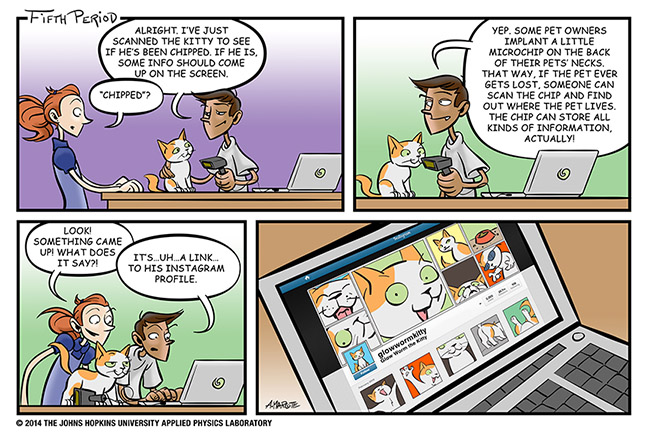
On the Right Track with RFID

What a bizarre cat—even though he’s “chipped,” whoever takes care of him clearly can’t keep a handle on his antics.… This little kitty’s microchip (which would normally be scanned by a vet or animal shelter to find out where to return him if he’s lost) has been repurposed into an instrument of Internet fame. But how can a tiny bit of electronics no bigger than a grain of rice—implanted just beneath the skin—reveal any information at all?
The secret to this kind of “smart” tracking is radio frequency identification (RFID). An RFID microchip is powered by the radio frequency emitted by an RFID reader, so the chip itself doesn’t need any kind of battery at all…which is why it can be so tiny! Because an RFID chip can store information, it’s being used for all kinds of things now. Big stores use RFID tags to keep valuable items from “walking” out of the store—if RFID readers stationed at the store’s entrance sense a tag with the information “NOT PURCHASED YET,” get ready for alarms! RFID can help prevent theft, but it can’t quite keep kitties out of sewers just yet…
Think about it!
Have you ridden the subway recently? Do you or your parents have a “smart card”—a fare card that’s refillable and looks like a credit card? If, when you enter a subway station, you have to tap or touch your smart card to a special place on the turnstile, that’s RFID at work! A tiny chip on the card stores information about how much money you’ve put on it. When the card reader “sees” that you have enough money to ride the subway, it lets you through! Can you think of anywhere else you might have seen something like this?
February 20, 2015
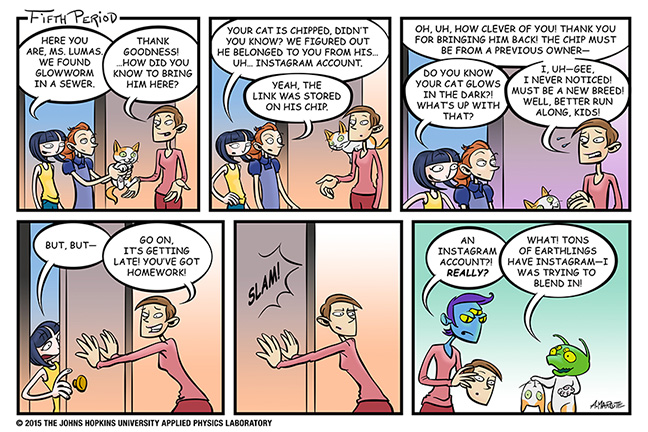
This Raises More Questions Than Answers!

So now we know the answer to the mystery of the bizarre glowing cat, because he’s an…alien? Oh come on, that’s not even possible…even if aliens did exist (I’m told they prefer the term “extraterrestrials”), what would they be doing on Earth anyway? And more importantly, what would they think of our Instagram photos?!
Actually, since the universe is such a big place, there are likely many planets that are capable of supporting life (whether they actually do is another matter!). What is it that makes a planet habitable? There are many factors, but one of the most important is the planet’s distance from the star it’s orbiting. Whether or not the planet is in the “habitable zone” will determine if it’s just the right temperature to sustain life! It goes like this: If a planet is too close to a star, it’ll be way too hot; if it’s too far away, too cold. Our Earth is in a habitable zone, making it the relatively cozy place we know it to be. When you put it that way, what extraterrestrial wouldn’t want to pop by for a visit?
Check it out!
Learn what some scientists are doing to probe the galaxy for more habitable planets. Turns out, finding other planets in nearby star systems is just around the corner. Still skeptical that habitable planets are out there? Check out this interactive website that shows the scale of the universe—saying it’s a big place is an understatement!
March 13, 2015
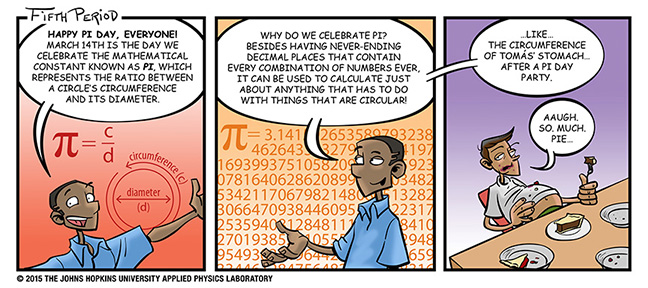
As Easy as Pi

Happy (early) Pi Day! You’ve probably heard of Pi Day before, but in case the news hasn’t circled back to you (ahem)…we celebrate Pi Day on March 14th because Pi is approximately equal to 3.14…get it? As Marcus says, Pi Day is all about the mathematical constant Pi, which is represented by the Greek letter π. When something is referred to as constant, it means it never changes. So, EVERY time we divide a circle’s circumference by its diameter, we always get Pi.
There are actually lots of mathematical constants that you’ll eventually learn about, so why is Pi so great? For one thing, Pi is irrational, which means you can’t calculate it by dividing two integers (a ratio), and it has decimal places that go on…well, forever. People are still calculating the decimal places…the last count was 13 trillion digits! But cooler than that, Pi actually shows up a lot of places: Not only can you use it to calculate the circumference, area, surface area, and volume of anything remotely circular, it pops up in calculations for number theory, cosmology, even fractals!
Try it yourself!
Let’s figure out just how wide around Tomás is after eating all the Pi Day pies. Emma measured the diameter of Tomás’ stomach by holding a yardstick up to his profile—and got 24 inches. Let’s approximate Pi so that π = 3.14. What is Tomás’ circumference if circumference = π × diameter?
Think you know enough about Pi? Try discovering Pi for yourself.
March 27, 2015
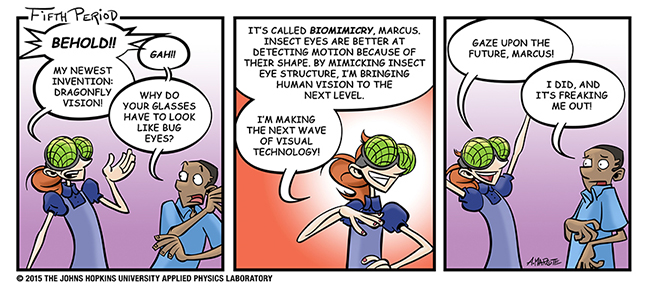
All A-Buzz about Biomimicry

The future can be freaky, but it can also be really cool, thanks to a little idea called “biomimicry”—that’s when engineering-minded folks like Emma mimic mechanisms in nature with their creations. Emma is mimicking the compound eyes of insects to find a new way to see things. Other clever people have invented a way for humans to climb walls based on the way gecko’s feet adhere to surfaces. Yet another group has developed a cheetah-like robot that runs and jumps! It’s all part of a bigger movement called bioinspiration, which is the idea that human problems can be solved by looking to biology for inspiration.
Think about it!
What’s something neat in nature that you wish humans could do? It could be how chameleons and octopi blend in with their background, or how monkeys can jump from tree to tree with the help of a prehensile tail. Get bio-inspired!
April 10, 2015
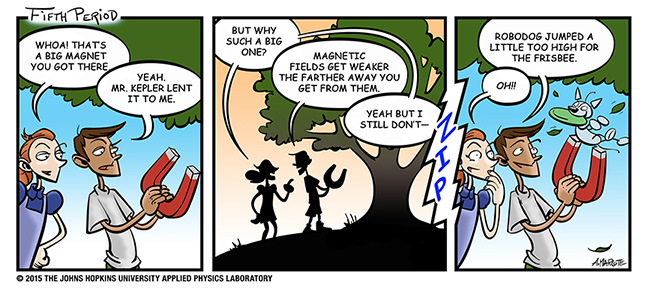
An Attractive Solution

Hooray! They’ve rescued Robodog with the magnet…. Now, how are they going to get him off of that thing?
Magnets are great for things other than saving mechanical pets from high places. In fact, you’re probably using bunches of magnets in your house right now. Just go check your refrigerator door. But, what’s actually going on here? What is this invisible force—magnetism—that attracts certain metallic objects to one another?
As you may already know, all matter is made up of particles called atoms, and atoms are made up of even smaller particles, like electrons. (Remember learning about those?) Electrons tend move around their atoms’ nucleus in an unsynchronized manner, but in some materials—like certain metals—the electrons will move in the same direction, and that’s when magnetism occurs! Learn more about how magnets work here.
Try it yourself!
Did you know that the Earth is a giant magnet? That’s because its core is a mixture of metals that give the planet a magnetic field. Earth actually has a magnetic North Pole and South Pole. That’s how compasses work: The magnetic needle inside is attracted to the North Pole and will try to align to it. Go here to find out how to make your own compass!
April 24, 2015
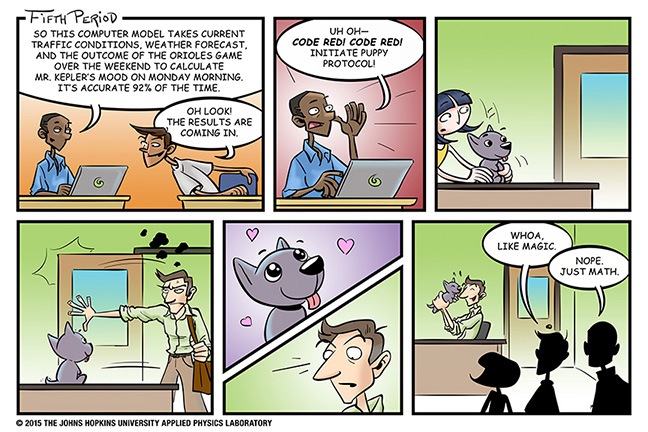
In a Calculating Mood

What an amazing power—to be able to predict your teachers’ moods—to know when they’re more likely to assign lots of homework. It may seem like magic, but in fact scientists and mathematicians have been using computer models to do exactly this kind of thing for all sorts of problems!
Alright, so it’s not likely that scientists are using computer models to predict moods, but it’s possible. Number-crunching computers these days can do millions of calculations per second, and wherever something acts a certain way based on certain inputs—or variables—a computer can run all sorts of scenarios to come up with a model of how something will react.
Computer models can have an impact on everyday life! Think about the weather forecast. Meteorologists can make predictions about the weather based on variables like last season’s temperatures, winds, ocean temperatures, land features, and much more! Want to learn more about computer models and what they’re used for? Check out this article.
Think about it!
What would you use a computer model to predict? What are the different variables your computer model would have to use?
May 12, 2015
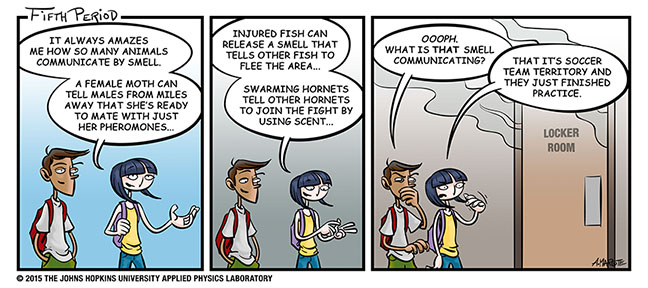
Smell Ya Later!

It seems like Sophie may have uncovered an interesting form of communication…. As humans, we’re accustomed to communicating with sound and sight. (“Sight,” you say? Think body language. We rely on it a LOT.) But other organisms use an arguably more powerful sense to communicate: smell! Lots of animals—and even some plants—use chemicals to send messages, and decode them with whatever olfactory organ they have at their disposal.
How can the sense of smell be a powerful communicator? (To be clear, not all animals “smell” like we do, but they have the ability to perceive chemicals in the air or water.) Well, for one thing, chemicals have the ability to travel much farther than an organism can see or hear. Sophie mentions moths; certain species can release pheromones that are perceptible more than 5 miles away—you try yelling that loudly. Learn more about how animals use chemicals to communicate here. Also, plants can communicate with chemicals too!
Think about it!
Can you think of a time when smell alerted you to a situation? What did you do as a result?
May 22, 2015
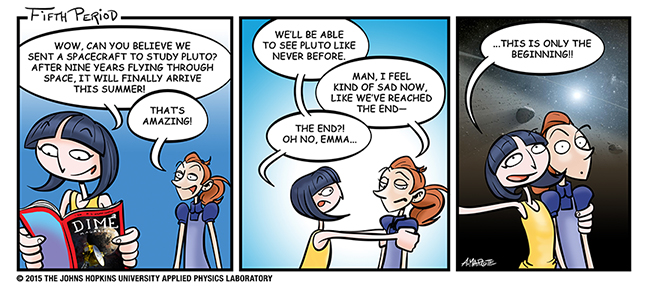
Something New on the Horizon

Think you’ve had a long school year? Ready for a break? Well, just imagine what NASA’s New Horizons spacecraft must feel like! It’s been traveling more than nine years across our solar system to get to Pluto, and it’s finally going to reach its destination in July, ready to make all sorts of fascinating discoveries about this faraway dwarf planet. And then its job is done, right?
Not quite. It turns out Pluto isn’t the only object at the edge of our solar system. It’s part of a mysterious region known as the Kuiper belt, which is filled with icy and rocky objects that might be leftovers from when the outer planets in our solar system were created. New Horizons is expected to explore other Kuiper belt objects in addition to Pluto, to learn more about how our solar system formed.
But what’s beyond the Kuiper belt, out in the Milky Way—the galaxy in which our solar system resides? A lot! The Milky Way galaxy is so big that if you think of our solar system as being the size of a quarter, the diameter of the Milky Way is roughly the size of the United States! Then consider that the Milky Way is part of something even bigger: the Laniakea Supercluster. And, well, you get the idea. As it turns out, our solar system is kind of a little fish in a VERY big pond! And that means there’s a lot out there for future scientists to discover!
Think about it!
Did you know that New Horizons has a science experiment on board that was built by students? If you could design an experiment to send into space, what would it study? Where do you hope it would go?
Also check out these exciting New Horizons activities!
Image Credits: NASA
June 8, 2015
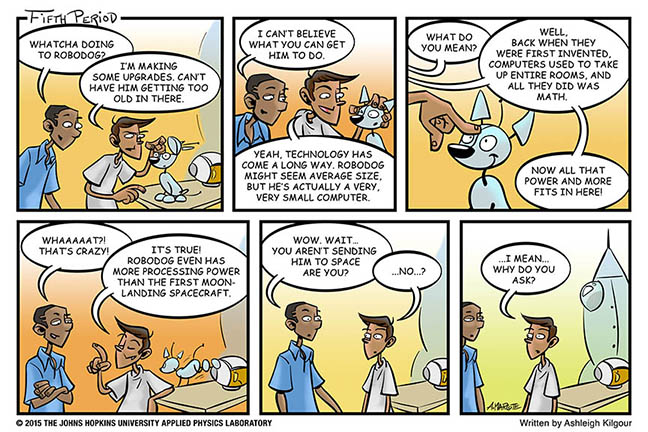
Robodog in Space?

While Tomás works to see if he can get Robodog space-exploration-ready, he brought up some pretty wild facts. How crazy is having giant computers? In the 1950s, it was completely normal for computers to almost or completely fill a room. Can you imagine a computer taking up an entire classroom? You’d have to reserve a whole section of a building just to compute math equations! (Which isn’t a great use of space, if you ask me.)
It’s also incredible how small computers have gotten over the years. As hard as it is to believe that Robodog has more power in his little head than the entire Apollo 11 spacecraft that took the astronauts to the moon for the first time, it’s true! In fact, you’ve probably held more powerful technology in one hand than there was on that spacecraft. Don’t think so? Well, if you’ve held a smartphone, you’ve done it. Today’s smartphones are much more powerful (and clearly much smaller) than Apollo 11 was when it landed on the moon.
Check it out!
Want to learn more about how computers got smaller as time went on? Click these links to view some really interesting timelines:
- http://www.tiki-toki.com/timeline/entry/58558/The-History-of-Computers/#vars!date=1936-09-01_00:00:00!
- http://www.computerhistory.org/timeline/?category=cmptr#top
That’s it for the school year! The Fifth Period gang wishes you a great summer. Many thanks to the APL STEM office, Don, Anne, Frank, Jon, Katie, Ashleigh, and Lynn, who made this year’s season successful. See you next fall—now go do something cool.
October 16, 2015
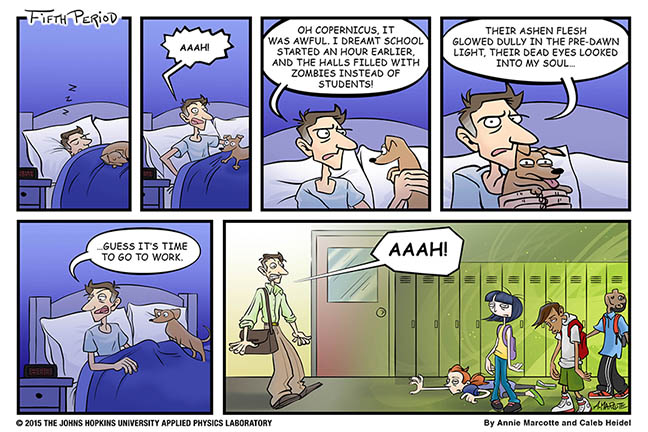
Circadian Nightmare!

Alas, summer break has come to an end, and it’s time for the Fifth Period gang to return to class. Have you ever felt less than human or zombie-ish as you’ve stepped through the doors of your school in the morning? There’s a very good reason for that, and it has to do with circadian rhythm. Your body (as well as those of many other organisms) runs on a roughly 24-hour cycle. Your circadian rhythm, or “body clock,” is what makes you want to sleep at about the same time every night.
But as a growing person, your body clock may be changing, causing you to fall asleep later and wake up later. It may be transforming you into—gasp—a zombie! That’s right, the tendency to sleep later combined with super-early school times may be creating hordes of groggy zombie-kids. Whatever will we do? Fortunately, there’s a cure! Your body clock is sensitive to light—this article details how you can reset your body clock with the proper application of light.
Check it out!
NASA scientists have been experimenting with circadian rhythm to see how humans are affected when there aren’t regular 24-hour cycles of day and night. Think about it! In space, there’s not really sunrise or sunset. Knowing how people function with disrupted biological clocks is key to the future of space exploration.
October 30, 2015
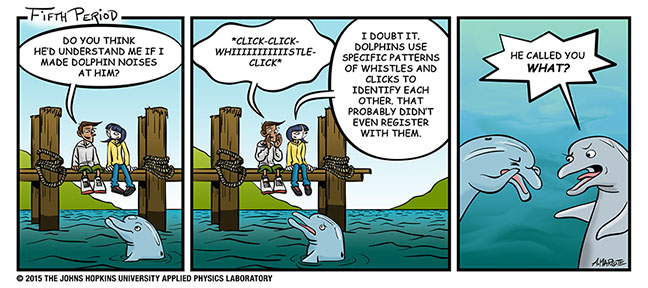
Watch Your Language!

It’s not likely that a dolphin would understand your imitation dolphin sounds, but you’d be surprised at what they CAN understand. In fact, many animals are thought to have a basic grasp of language. You may find that obvious, since all animals can communicate right? Shoot, lots of bugs and even some plants can communicate with chemicals (Remember this comic?), so what’s the big deal?
Language is more than just sounds and chemicals; language consists of symbols, which are sounds or gestures that have specific meanings attached to them. And unlike other forms of communication, language has to be learned. Dolphins and whales in particular learn vocalization from their parents. Read more about vocalizations of these and other animals here. Apes like chimps and gorillas can learn human sign language. So if animals have the capacity to learn a language, could we ever decode their own animal language? No one is quite sure yet!
Try it yourself!
Listen to some recordings of dolphin-speak, and see just how different dolphin signature whistles can be.
November 6, 2015
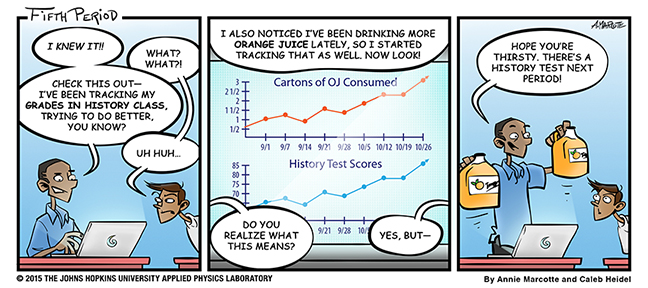
A Juicy Correlation

Marcus has discovered something very interesting indeed, and that is that sometimes statistics can be misleading. What…you thought I was going to say “drinking healthy fruit juice will help you do better on tests”? HA! If only it were that easy.
Marcus’ graph is quite amazing, actually: It seems to show that his orange juice intake positively correlates with his test scores—that means, the more OJ he drinks, the higher he scores (on that note, something that negatively correlates would be the opposite: drinking more OJ would mean his test scores go down). But…that can’t be true. It’s just crazy to think that because the two aren’t related at all! It’s purely coincidence.
That’s why statisticians have to be careful when they see correlations in studies. If they don’t consider and control for all the other possible reasons for a correlation, they could wrongly assume that one thing causes the other. That’s what they mean when people say correlation does not imply causation.
Check it out!
One man took it upon himself to dig up as many unrelated correlations as he could, to show how things that are less-hilariously unrelated can mislead us. Just look at some of these wacky correlations! Who would have thought mozzarella consumption is linked to the number of civil engineering degrees awarded? …It’s not, I promise.
November 20, 2015
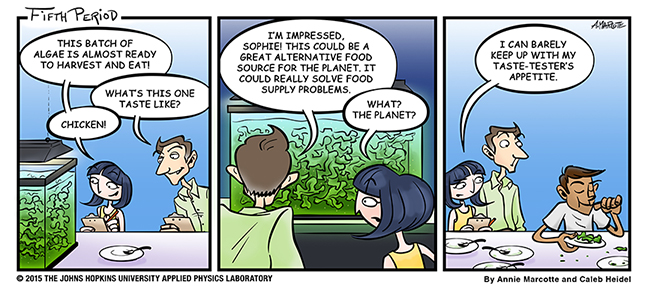
Hope You’re Hungry

Algae that tastes like chicken sounds ridiculous, but it’s not impossible. In fact, scientists have recently started experimenting with seaweed that tastes like—get ready for this—BACON.
Why are scientists interested in such unusually savory vegetation? It’s all because the human population has such a large demand for food, but traditional farming methods may not be able to keep up as the demand grows. Growing crops takes up a lot of space, and raising livestock takes even more. Actually, livestock ends up eating a significant portion of the crops we grow in the United States.
It has people considering alternative food sources such as seaweed, meat grown in a lab, genetically modified livestock, and bugs. If that sounds gross, consider that many cultures around the world eat bugs, sometimes as treats! All of these new food sources (especially seaweed and bugs) are attracting attention from scientists because they are easier to produce sustainably.
Try it yourself!
Feeling adventurous? You can experiment with alternative food sources yourself by snacking on crickets, a favorite in many cultures across the world! Enlist the help of an open-minded adult to purchase some crickets from a reliable source—don’t go catching them out in the wild. Then, check out these recipes for common ways to cook these critters. Bon Appetit!
December 4, 2015
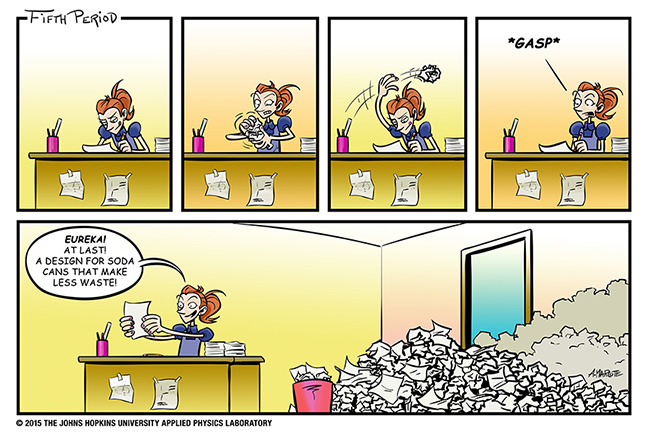
Design with Less Waste in Mind

We use a LOT of products in our daily lives. Just think about all the things you use before leaving for school in the morning—OJ bottles, milk cartons, toothbrushes, clothes, socks, shoes, lunch bags, paper towels—the list goes on and on, and that’s just a small part of the day! Eventually, a lot of that stuff will get thrown away or recycled. One person can go through a lot of stuff, and multiplying that by the entire population means a LOT of waste!
Enter creatively minded engineers and designers, who are getting crafty about the products and packaging we make. Take for instance, the plain old water bottle. Companies have figured out that if they make the caps just a bit smaller, that equals a HUGE reduction in the amount of plastic waste that’s generated. Think about it: if you took away just a tiny bit of plastic from all of the millions of water bottles people drink, you’ve just saved literal TONS of plastic!
Try it yourself!
Think of a common household object you use all the time. How could you redesign it using less material? Or what’s another way you could use it after it no longer serves its original purpose?
December 18, 2015
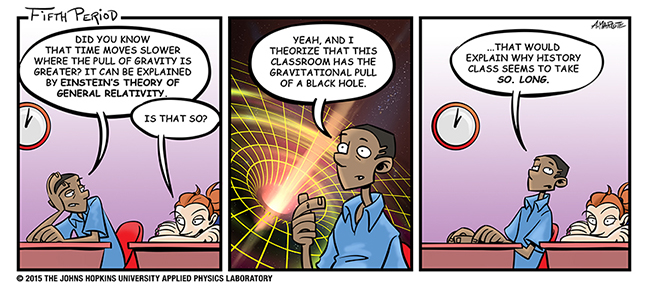
Relatively Speaking...

We all know that feeling, Marcus. The clock always seems to move slower during class, particularly if the lessons aren’t interesting. But if time appears to move slower in school, it’s probably due to boredom—NOT Einstein’s Theory of General Relativity, like Marcus thinks. But let’s give him a break, since this theory hasn’t actually been around for very long and has fundamentally changed how we view the universe.
So, what is the Theory of General Relativity then, and why does time appear to slow down where gravity is greater? The answer is quite complex. To know this, we have to go back many years ago, to 1915, when young scientist Albert Einstein observed that when light passes by a massive object in space (like a planet or a black hole), it’s path is curved. This is because massive objects contort the shape of space with their gravity. Einstein’s Theory is all about this space–time curvature.
If space around an object is curved, light (which travels at a constant speed throughout the universe) has a greater distance to travel. BUT, the speed of light has to stay the same! It’s constant! So, how does something going the same speed travel a greater distance in the same amount of time? Time has to slow down. To an observer inside that field of gravity, the passage of time will appear normal (sorry, Marcus), but an outside observer will notice that time has slowed relative to their own passage of time!
Does this sound strange and confusing to you? If so, you’re not alone. Read more about Einstein’s discovery here. Still confused? Try out this explanation for the Theory of General Relativity…it only gets weirder!
Check it out!
Want to stretch your mind a little more? Listen to famous astrophysicist Neil deGrasse Tyson explain how gravity affects time.
January 8, 2016
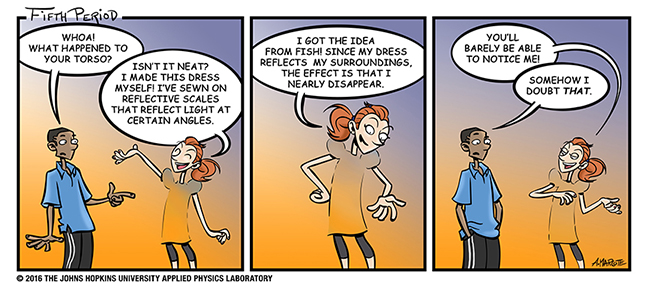
Relatively Speaking...

We all know that feeling, Marcus. The clock always seems to move slower during class, particularly if the lessons aren’t interesting. But if time appears to move slower in school, it’s probably due to boredom—NOT Einstein’s Theory of General Relativity, like Marcus thinks. But let’s give him a break, since this theory hasn’t actually been around for very long and has fundamentally changed how we view the universe.
So, what is the Theory of General Relativity then, and why does time appear to slow down where gravity is greater? The answer is quite complex. To know this, we have to go back many years ago, to 1915, when young scientist Albert Einstein observed that when light passes by a massive object in space (like a planet or a black hole), it’s path is curved. This is because massive objects contort the shape of space with their gravity. Einstein’s Theory is all about this space–time curvature.
If space around an object is curved, light (which travels at a constant speed throughout the universe) has a greater distance to travel. BUT, the speed of light has to stay the same! It’s constant! So, how does something going the same speed travel a greater distance in the same amount of time? Time has to slow down. To an observer inside that field of gravity, the passage of time will appear normal (sorry, Marcus), but an outside observer will notice that time has slowed relative to their own passage of time!
Does this sound strange and confusing to you? If so, you’re not alone. Read more about Einstein’s discovery here. Still confused? Try out this explanation for the Theory of General Relativity…it only gets weirder!
Check it out!
Want to stretch your mind a little more? Listen to famous astrophysicist Neil deGrasse Tyson explain how gravity affects time.
January 22, 2016
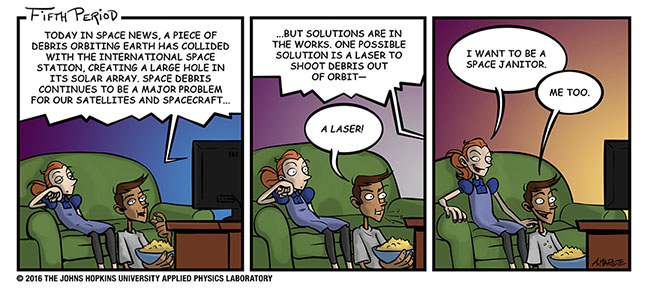
Talking Trash about Space

In just a few short decades, people have made amazing strides in space exploration. From the very first manned mission in space to global communication networks powered by satellites, we have certainly come a long way. However, we seem to have left a bit of a trash trail in our wake. Well, more than a bit…more like thousands of tons of trash (!!). It’s all discarded satellites and debris from collisions. It’s a big problem too: space trash in our orbit can collide with working satellites, even the International Space Station.
What to do?! Fortunately, bright minds are starting to consider the problem of cleaning up space trash. One possibility: a laser that can pulverize bits of space trash. It’s not as far out as you think! It’s not the only plan in the works, either—and none too soon, because Earth is surrounded by a veritable cloud of junk.
Think about it!
How would you tackle the problem of space trash? What kind of contraption could you think up that could either collect or destroy it?
February 5, 2016
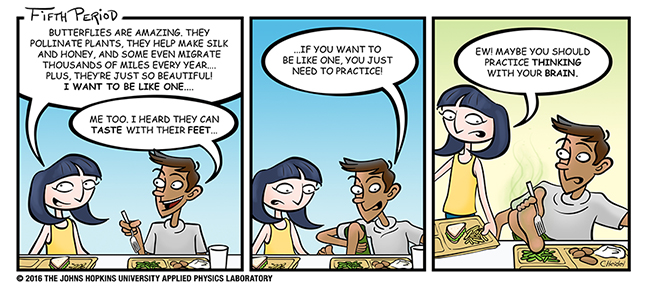
Professional Pollinators

So what did you eat for lunch today? An apple or orange? Carrots? Chances are, some of your food was produced with a little help from butterflies! Like honeybees and bumblebees, these fancy flittering bugs play a big part in pollinating plants that produce many of the fruits and vegetables you eat! If only we could ask the butterflies to make less broccoli and spinach…
So what is pollination anyway? Put simply, it’s an exchange of pollen from one plant to another. This process is necessary for plant reproduction and is also part of a butterfly’s daily routine! Pollination happens as a butterfly travels from one big, comfy flower to the next, slurping up nectar and collecting pollen on their legs. When landing on a new flower, pollen falls off the butterfly and onto the pistil (the female part of a flower), causing it to create new seeds. This process is repeated over and over again on a daily basis, allowing plant life to thrive!
Try it yourself!
Sophie is right to love these cool insects; they play a large role in our environment. So what can you do to help these guys? Well, you can start by building a butterfly garden with an assortment of wildflowers and other plants butterflies like, such as dill and fennel. Place your garden by a tree for shelter and put out a bowl to collect rainwater—butterflies get thirsty too! To learn about what plants to include in your garden, check out this website.
February 19, 2016
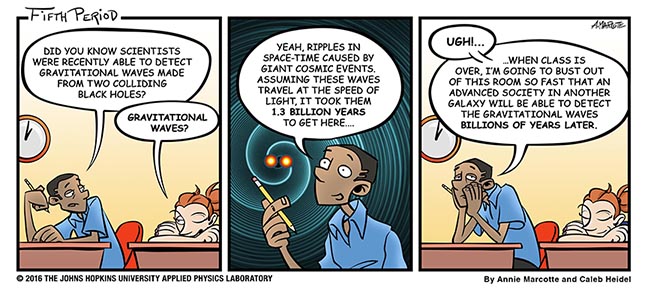
Making (Gravity) Waves

Wow, Marcus sure is excited to get out history class! And speaking of history, scientists have made it again with the recent discovery of gravitational waves. You may remember from this comic that Marcus was ruminating on Einstein’s General Theory of Relativity and the apparent effect that gravity has on the fabric of space-time. Einstein also theorized that matter (think HUGE—like stars) could create radiating ripples in space-time if they did something like, oh I don’t know, smash into one another. Think about it: all matter in the universe alternately compressing and expanding, like ripples in a pond—wild! But even after such a violent event, the gravity waves would be very subtle, barely perceptible above the background “noise” of the universe. Well, Marcus, so much for making an impression on a future space society with your big bust-out!
But now, thanks to the Laser Interferometer Gravitational-Wave Observatory (LIGO), these elusive waves have finally been detected! The Observatory relies on the beams of light (the fastest in the universe) to detect the minute compressions of the Earth. Read more about the discovery here.
But why care about such waves if they’re so small and barely noticeable? What does it mean for the study of space? That’s the best part—no one knows yet! We now have a new way to look for things in the universe, which means we’ll likely discover something completely new soon.
Check it out!
Have a question about the gravitational wave discovery? So does everyone else—see the conversation the world is having with LIGO scientist Dr. Amber Stuver.
March 4, 2016
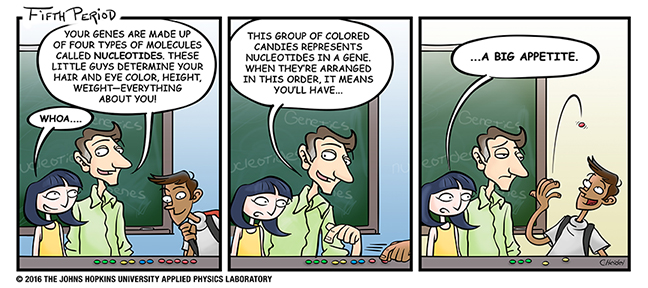
Sweet, Sweet Genetics

Have you ever had to put something together with a set of instructions, like a model airplane? Well, your body does this every day! I know that sounds odd, but hear me out. In every cell, there are little sets of instructions called genes. Your cells follow these instructions when they produce proteins. The information inside these tiny genes determines big things, such as your appearance, how you are to survive, and how you will interact with your environment.
Before Mr. Kepler was rudely interrupted by Tomás’ appetite, he explained that each gene contains four kinds of nucleotides (adenine, cytosine, guanine, and thymine); you can imagine them as red, blue, green, and yellow building blocks. Inside of a gene, thousands of “colored blocks” are lined up in a unique combination, like a code! Your cells read this code language to learn about your body. Cool, right? A particular sequence of nucleotides can tell your cells that you have green eyes, small feet, red hair, or a big appetite!
Try it yourself!
Even the ability to wink is determined by your genes! To find out if this is trait in your family, find a parent or sibling and ask whether he or she can wink. Then ask a few more family members and record this information on a piece of paper. If you find that most of your test subjects have this ability, then winking most likely runs in your family! Want to do more researching? Try this experiment again for other characteristics, like wiggling your ears or rolling your tongue.
March 25, 2016
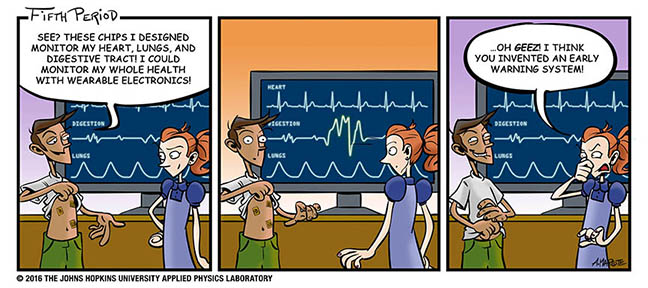
Electronics Everywhere!

What do you think of when you hear the word “electronics”? Does it bring to mind big, boxy computers that break easily, or a smartphone that would shatter as soon as you dropped it? It’s hard to imagine that something like a microchip could be attached to someone’s body to monitor their health, but that’s exactly what materials scientists are working to figure out! Flexible, wearable electronics are changing the way we think about and perceive our health (and they’re certainly changing the way we see Tomás’ digestive health!).
And not only are we making electronics to wear on our bodies, we’re making them to be powered by our bodies too. Just think: in the future, pacemakers (devices that correct problems with the heart) will be powered by the body’s kinetic energy—whereas now, pacemaker patients have to have surgery every 10 years or so to get batteries replaced.
Think about it!
Did you know wearable electronics could be used to administer personalized dosages of medicine? Korean researchers are developing “electronic skin” that can do just that—check it out! Can you think of any other cool uses for wearable electronics?
April 8, 2016
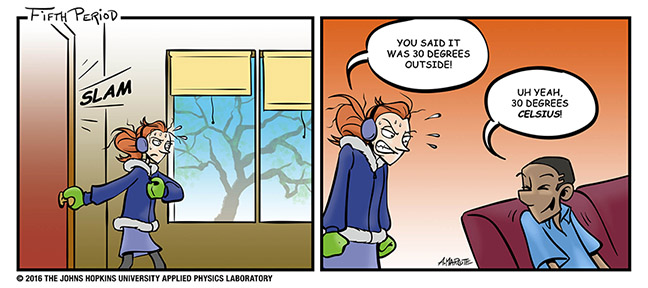
Off the Scale with Celsius and Fahrenheit

Boy, spring really does bring some crazy temperatures. It could be as cold as 30° or as warm as 30°! Oh, you’re confused? Well, 30° means totally different temperatures on different scales. The Celsius and Fahrenheit temperature scales are the most commonly used in the world. If you’re living in United States, you’re probably used to hearing about things in degrees Fahrenheit (and you’d probably be pretty miffed at Marcus too).
What’s the real difference between these scales, then? It all has to do with reference points. Anders Celsius, a Swedish astronomer who is credited with developing—you guessed it—the first Celsius temperature scale, set the boiling point of water at 0°C and the freezing point of water at 100°C…. No, I didn’t mix that up! People later switched that around so that the freezing point is 0°C and the boiling point is 100°C. Most of the world uses this temperature scale now.
Daniel Gabriel Fahrenheit, on the other hand, developed the Fahrenheit scale using a different substance to come up with his “zero” point. He set 0°F to be the point at which a water/ice/brine mixture stabilizes in temperature. He also based his reference points on a different scale—the Rømer scale—which says that brine freezes at 0°, water freezes at 7.5°, and boils at 60°. Fahrenheit wasn’t too fond of decimals, so he multiplied those numbers by 4 (also to give the scale more granularity). Those numbers were refined in later years to say that water freezes at 32°F and boils at 212°F.
You didn’t think something like reading the temperature had such a complex history, did you? Be sure to read more about Celsius and Fahrenheit; there’s even more to it.
Try it yourself!
You can convert Celsius to Fahrenheit by multiplying the degrees in Celsius by 9, then dividing by 5, and then adding 32.
You can change it back to Celsius by subtracting 32, multiplying by 5, and then dividing by 9.
Try it and confuse your friends!
April 22, 2016
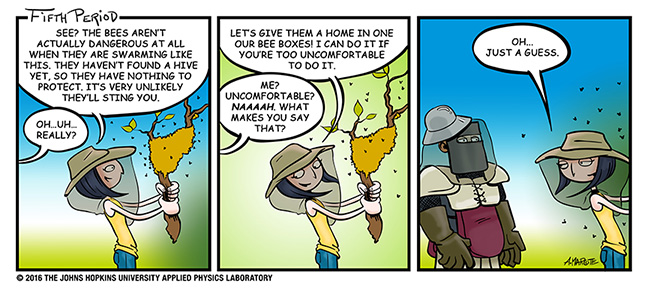
Swarming up to the Idea of Bees

What do you know about bees, specifically honeybees? You probably already knew that they’re responsible for making the honey you see stocked in the grocery store. But honey production is probably the least interesting thing they do! Remember from this comic that they’re one of the most important pollinators and make growing fruits and veggies all over the world possible.
One cool thing about honeybees is that they form swarms as part of their reproductive process. A queen bee (a bee that’s capable of laying eggs) will leave the original hive and take thousands of worker bees with her. This swarm will hang out on something like a tree branch while a few “scout” bees go out in search of a new permanent home. If the swarm is lucky, a kind beekeeper will transfer the bees to a beebox with everything they need to start a new hive.
Bees, of course, are known for their stings as much as they are for their honey—but funnily enough, bee swarms are not aggressive when they’re looking for a new home because they have no home and brood to defend. (Still, best not to provoke a bee swarm; leave approaching a swarm to someone who knows what they’re doing.) But there’s no need to be scared! Learn more about the bee swarm phenomenon here.
Check it out!
If you notice a bee swarm, don’t call an exterminator, call a beekeeper! Beekeepers would love the opportunity to take a swarm off your hands and won’t even harm the bees! Everyone wins: You, the beekeeper, the bees, and all the plants and trees that need pollination.
May 6, 2016
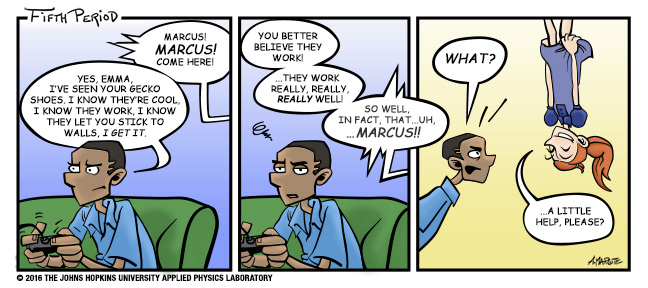
Trouble Is a Foot

Emma is at it again! Once again, she’s looking to nature for inspiration for her inventions, and nature never disappoints. Her last bioinspiration was an “invisibility” dress that mimics how some fish camouflage themselves with their scales—this time, it’s off the walls (er, on the walls?) with gecko feet! It’s not hard to imagine how gecko shoes might come in handy. In fact, the Defense Advanced Research Projects Agency (DARPA) is already looking into ways of giving people gecko powers.
Ever wonder how some gecko species can scale smooth, vertical surfaces? It has to do with microscopic structures on their feet called spatulae. These tiny bristles essentially increase the amount of contact that the gecko’s feet have with whatever surface it’s crawling on. With the extra surface area contact comes a sort of electromagnetic pull...almost like static electricity. While it’s a pretty weak attraction, a gecko is small enough that it works just great for scurrying up and down walls!
Check it out!
The science behind geckoes’ ability to climb walls has another great use as well: Dry adhesives! Companies are using nanostructures to make sticky materials with applications that range from medical (to replace sutures) to recreational (super gripping sports gear?!).
May 20, 2016
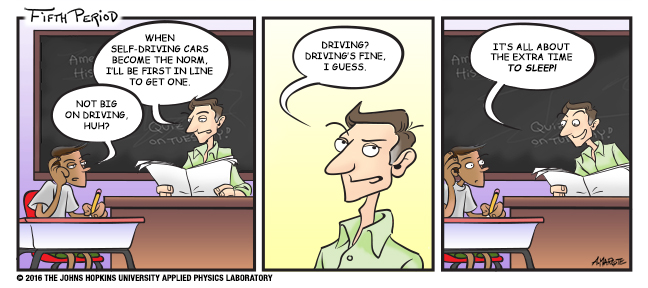
Driving into the Future

Imagine a world where you get into a car, tell it where to go, and then kick back and relax as it zooms off to your destination. Well you don’t have to imagine that much longer—it’s fast becoming a reality! In fact, some folks are predicting there will be a lot of self–driving cars on the road in the next couple of years.
What exactly is a self–driving car, and how does it work? Well it’s a lot like a regular car… minus the brake, accelerator pedal, and steering wheel! The self–driving car prototypes that currently exist are powered by battery. The model that Google is building uses lasers to sense obstacles around it (like other cars or pedestrians). And of course, self–driving cars navigate using GPS. Learn more about Google’s self-driving car here.
Think about it!
Mr. Kepler knows how he would use the extra time that he would normally spend driving… How do you imagine your life changing with self-driving cars? How would your day be different if you had one?
June 17, 2016
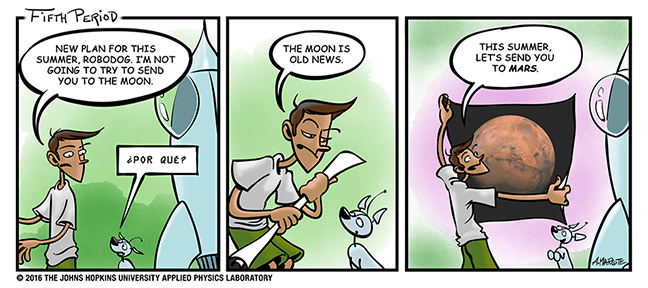
Headed Out of Town for the Summer

Summertime is here, and the Fifth Period gang is ready to go on vacation! Some might be headed to the beach, others might be headed to camps, more might be chilling at home, and one may be headed to…Mars? Really?! That’s a joke, right?
Whether or not it’s possible for Tomás to send Robodog to Mars (let alone get him into space), there’s no doubt that people are starting to get serious about Mars. Of course, there have been multiple unmanned and robotic missions to Mars already. But that doesn’t seem to have squelched people’s desire to go there, in the flesh. A manned mission to Mars is still a long time off in the future, but the conversation is happening.
Check it out!
You can visit Mars—virtually! Using the Google Earth application, you can download a Mars Map that lets you see up-close NASA imagery and take a virtual tour of the planet. See you there!
October 7, 2016
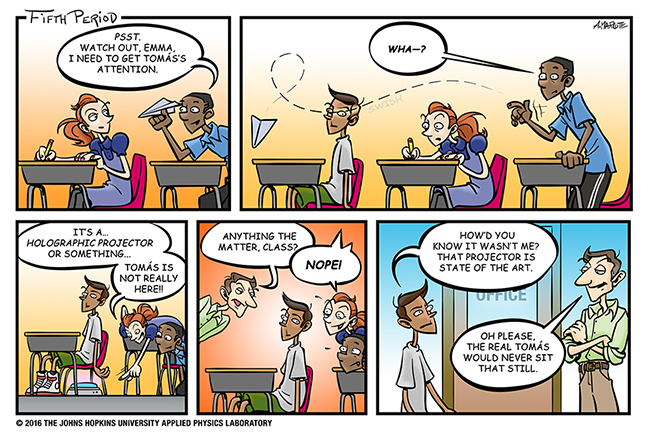
More Than Meets the Eye

Welcome back! The Fifth Period gang is back from vacation and ready to start school again…well, most of them are anyway. Boy, Tomás really goes all out when it comes to finding a way to get out of class—even going as far as inventing technology previously only seen in science fiction movies!
But things like 3-D holographic displays aren’t really the stuff of sci-fi anymore, at least, not for long. The cool displays that you’ve seen in movies like Avatar, Star Wars, and Jurassic World are actually making their way into the real world. For instance, take a look at the Urban Photonic Sandtable Display, a 3-D holographic table developed by the Defense Advanced Research Projects Agency (DARPA) that will let warfighters assess complex urban battlefields. This type of technology is still many years off from being a regular thing, but some companies are finding other ways of bringing crazy, sci-fi level displays to fruition.
Think about it!
Think about your favorite science fiction movie. What cool technology used in that movie would you like to see made in reality?
October 21, 2016
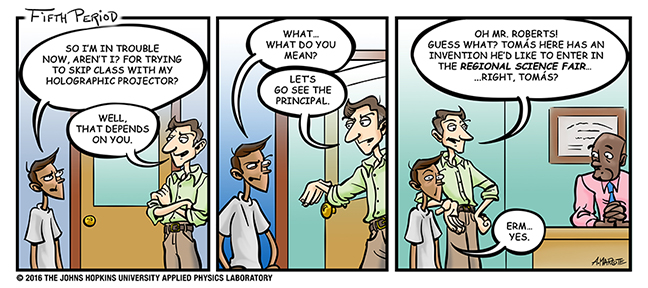
Fair Game for Science Fairs

You’ve heard of them, and you’ve probably even participated in one—science fairs are practically a rite of passage for students interested in STEM. Lots of schools even require you to participate. It can be pretty nerve-wracking trying to think of a project, gather the materials, put it all together, and then present it all in front of your peers! Sheesh! Tomás may not be in trouble anymore, but he’s got quite the challenge in front of him.
But it’s not really worth stressing out about. Just remember, all good science—whether it’s a simple experiment (like figuring out the quickest way to make bread rise) or a more complex invention (like Tomás’ holographic projector here)—is rooted in the Scientific Method or the Engineering Method! It’s all about asking questions and identifying problems. And the results are important regardless of whether or not they prove a hypothesis or solve the problem, because they increase our understanding of the world around us!
Try it yourself!
Take a look at the steps in the Engineering Design Process. Can you identify what Tomás probably did for each step? What’s an engineering problem you want to solve? You don’t have to have the solution just yet!
November 4, 2016
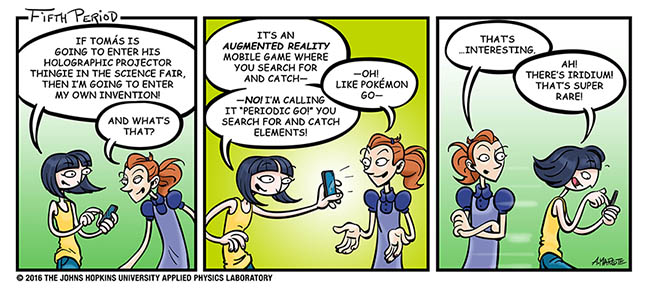
Gotta Discover Them All

Chemical elements make up all matter. There are 118 unique chemical elements (that we know of) that combine in countless ways to create every substance in the universe! Sophie’s got an interesting approach to learning about them. While there may not be an awesome mobile game for discovering elements (yet!), you can still learn a lot about them with a tool called the Periodic Table of Elements. This simple grid contains a LOT of basic information about every known element. Watch this video for a good introduction to all the information it provides.
Try it yourself!
Take a look at Ptable, an interactive Periodic Table. There’s lots to discover! Here are a few things to try:
- Click on any element and read what comes up about it. Is it rare? Is it naturally occurring? What’s its room temperature state?
- Play with the time scrubber to see when different elements were discovered. How many elements were discovered in the last 50 years? How about the last 10?
- Click on the “Compounds” tab at the top. Select a couple of elements and see what chemical compounds are made up of those elements. Clicking one element will highlight all other elements that can combine with it. Try and “make” a really complex chemical compound with as many different elements as you can. Can you find which element or elements can combine with the highest number of other elements?
November 18, 2016
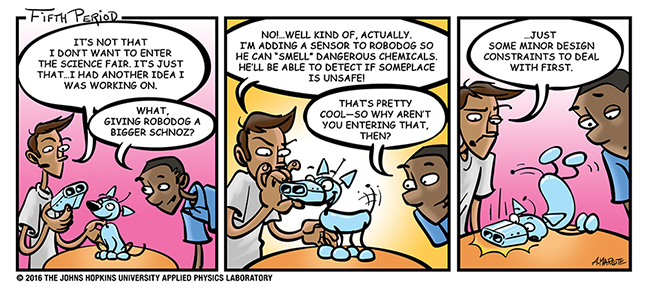
Get a Whiff of This!

We’ve already explored with Sophie how smell can be a powerful communication tool for animals and even plants, but we never talked about just how amazing of a detection tool the olfactory sense can be! Surely you’ve heard of or even seen drug-sniffing or bomb-sniffing dogs in large public spaces. That’s because, a while back, some smart people figured out how to train dogs to use their incredible sense of smell to sniff out harmful substances and alert their handlers. Dogs’ noses are so sensitive that the medical community is even putting them to work to detect cancer and monitor blood sugar levels in diabetics!
Now Tomás wants to take that idea to the next level: retrofitting a chemical sensor onto Robodog to give him a sense of “smell.” Let’s just hope Robodog can handle his new upgrade!
Check it out!
Learn about the history of the first bomb-sniffing dog and how dogs are trained to do this kind of work. Like Tomás, scientists and engineers have taken note of dogs’ keen sense of smell and are working on sensors that mimic it.
December 9, 2016
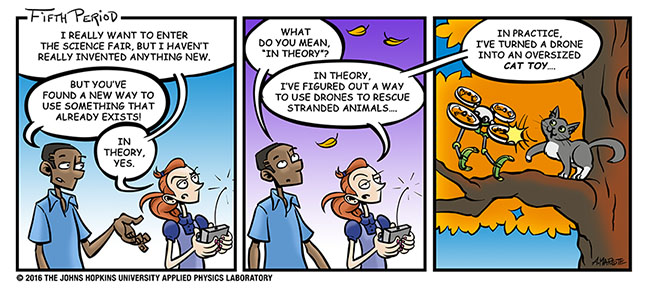
Technology to the Rescue!

People are constantly thinking of new ways to repurpose technology to solve tricky problems. Drones (unmanned aerial vehicles) especially have begun sweeping in the solutions. (Related: Remember Tomás’ quadrocopter experiment?)
Need to take some stunning video footage of a hard-to-reach place? Leave it to drones. Also, not too long ago, Facebook CEO Mark Zuckerberg announced the successful test flight of a drone that would bring the Internet to some of the most remote regions of the world. And of course, now companies are eyeing drones as a way to make deliveries of everything from packages to pizza.
Check it out!
While Emma may still have some kinks to iron out with her drone-based rescue device, other folks already have their repurposed drones working to help critters. Check out how U.S. Fish and Wildlife Service scientists are using drones to vaccinate endangered black-footed ferrets!
January 13, 2017

Getting into the Algorithm

Whether or not Marcus’s science fair submission becomes a self-fulfilling prophecy, you can’t deny that what he’s trying to do is pretty amazing. And yet, it’s not all that unusual, either. Scientists and researchers use math everyday to make computer models of everything from weather to earthquakes (Marcus used math to predict his teacher’s mood, too). Well, computer models will use algorithms—specific sequences to follow when conducting calculations—to achieve these things.
How might Marcus’s algorithm to predict who will win the science fair work? Assuming he knows who else is entering and the subject of their submissions, he could run a sequence of calculations that look at how much research the student did (maybe by counting their citations), how popular the subject matter is (by looking at how many times people searched for the subject on the web), and whether or not the student was able to produce any results. Will it be 100% accurate? Doubtful. Is it a good start? Definitely!
Check it out!
Algorithms can be used for more than just predicting things. Check out how one teen is using them to scour the galaxy for planets!
February 3, 2017
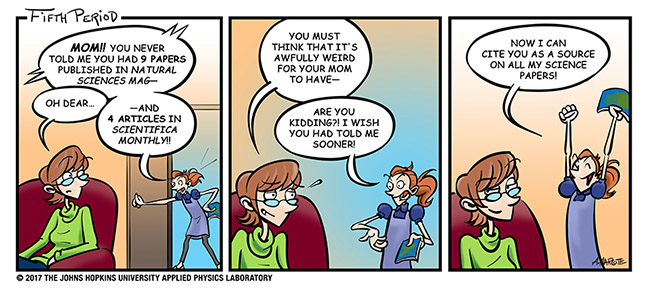
Giving Girls the Spotlight

What a surprise (and a delight) for Emma to find out her mom is a prominent scientist! Her mom is probably just modest, but it’s actually not as odd as you think for Emma not to have known. Although women have been doing groundbreaking STEM work and making incredible discoveries for as long as scientific progress has been made, up until very recently, it’s been unusual for them to be household names in science.
But many remarkable women of science are now finally getting their long-overdue time in the spotlight: To name a few, there’s Maria Sibylla Merian, a prolific 17th-century naturalist, botanist, and entomologist; Rosalind Franklin, the chemist whose work was important to the discovery of DNA; and Grace Murray Hopper, a computer scientist who developed the COBOL computer programming language. And let’s not forget the late Vera Rubin, the astrophysicist who discovered evidence for dark matter. The list goes on and on!
Think about it!
A movie about African-American women computers at NASA was recently the number one movie in the United States. If you could make a movie about a real-life science heroine, who would you pick?
March 17, 2017
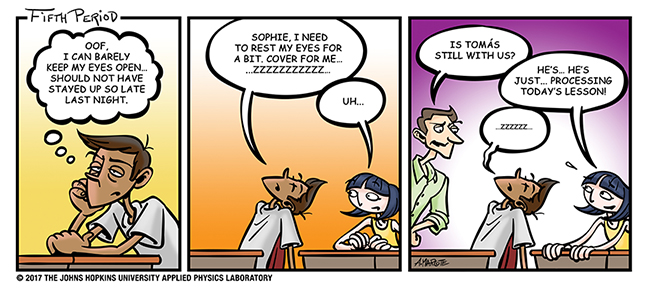
Sleeping? Forget about It!

What is your brain up to when you’re sleeping? There are lots of theories, but one thing is certain: Quite a bit of activity is going on, and good sleep is crucial to a healthy mind!
One theory is that the brain uses sleep time to clean out excess information. Over the course of a day, your brain creates tons of new synapses as it learns things. At night when all is quiet, the brain can “prune” the unneeded ones. So, Tomás may be taking a rest, but his brain is using that time to catch up to all the things he’s learned that day.
Another theory is that your brain uses that time to clear out disease-causing cellular waste that’s built up over the day. Scientists have found that animals’ brain cells can shrink to allow fluid to flow freely through the tissue, essentially giving the brain a “bath,” which gets rid of accumulated proteins linked to diseases like Alzheimer’s. Tomás is not just snoozing in class, he’s keeping his brain healthy!
Try it yourself!
You can test how nimble your brain is with and without good sleep. Try to memorize a list of vocabulary words, go to bed early, and then recall as many words as you can the next day. Repeat the same experiment with a new list the next night, but stay up a few hours later (getting up at the same time the next morning). See how well you can recall your second list compared to your first.
July 21, 2017

First at the Science Fair

Tomás never even planned to enter the science fair, so imagine his surprise when his favorite side project (and all-around pal) Robodog took the prize. Looks like his passion paid off!
The Fifth Period gang has had a lot of great adventures over the years, so imagine what they can do when they go off to high school. Big things are in store for them, and for you too!
August 4, 2017
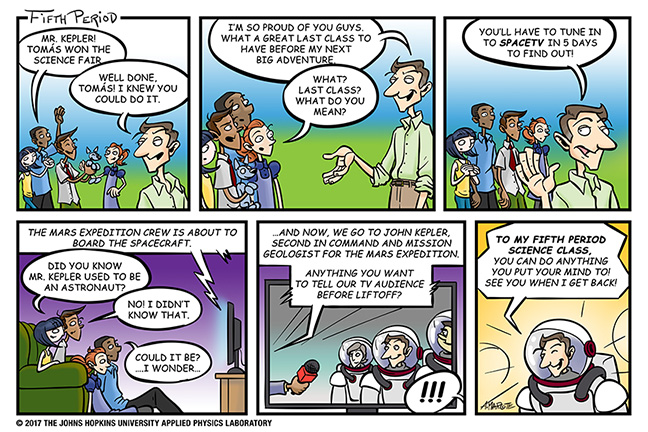
So Long, Fifth Period!

Thanks to everyone who read and tagged along with the adventures of the Fifth Period kids. We hope you enjoyed them and that you’ll go out and have your own STEM-inspired adventures!

